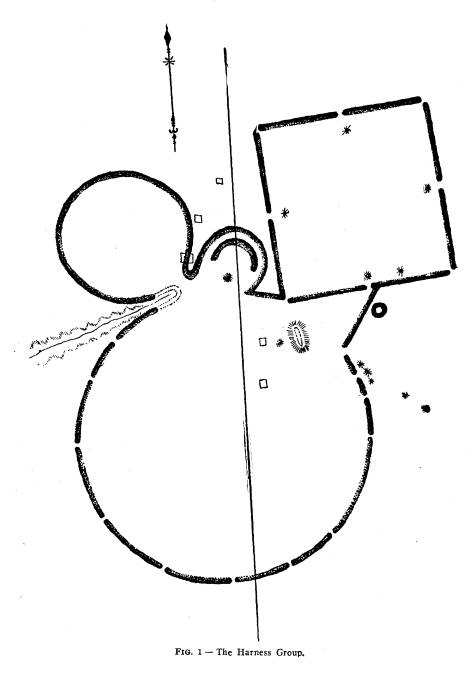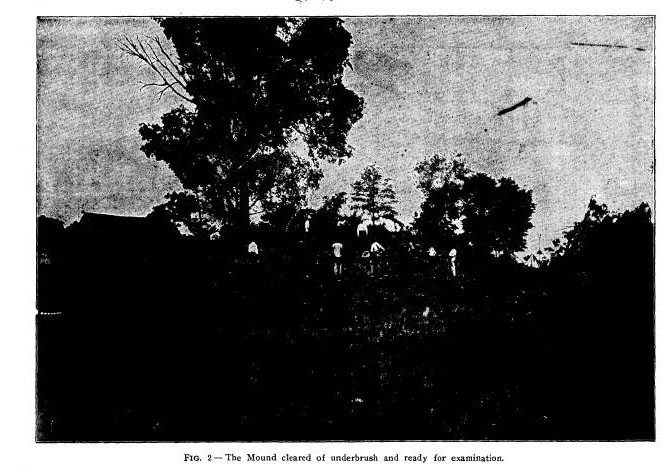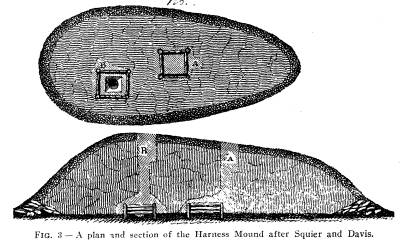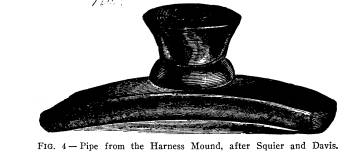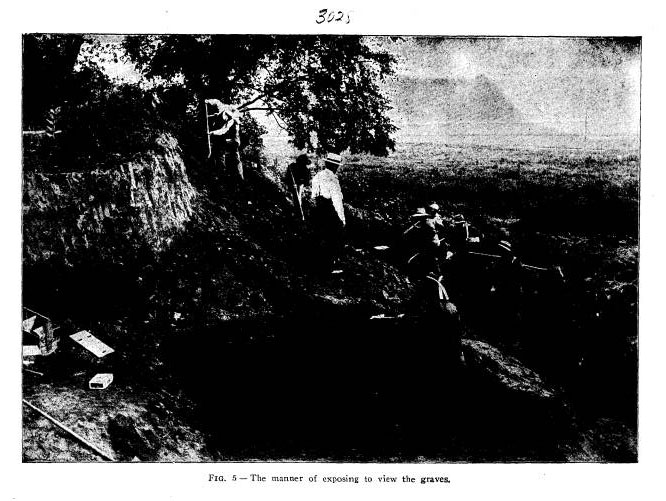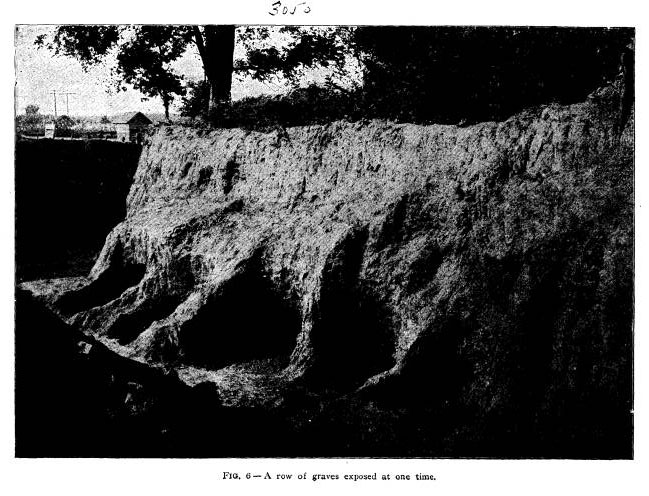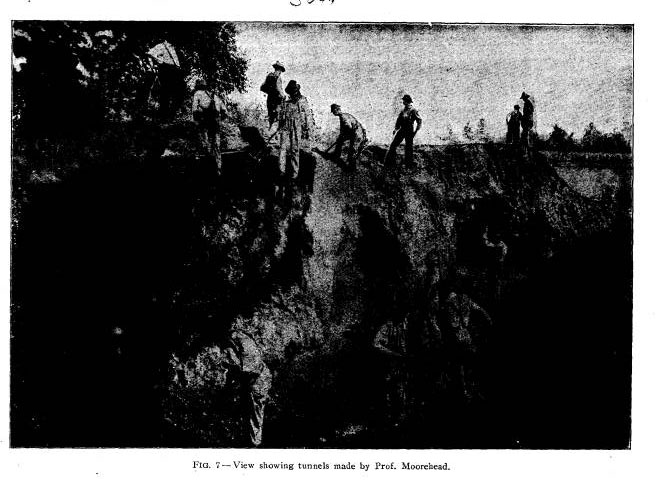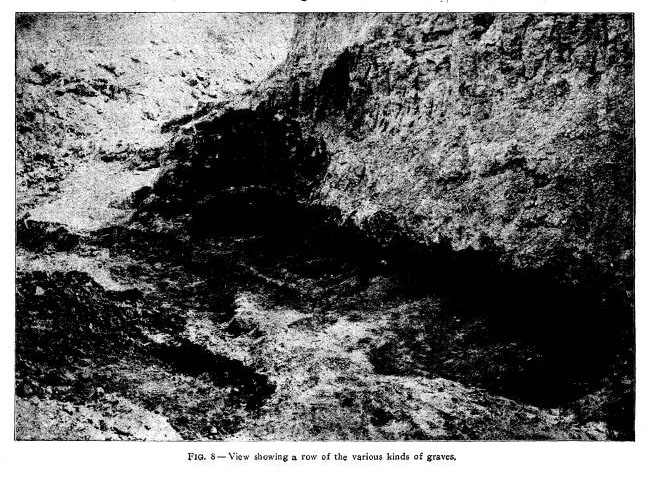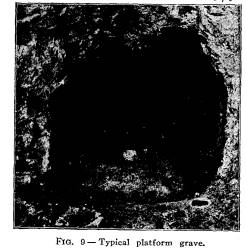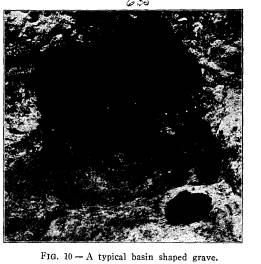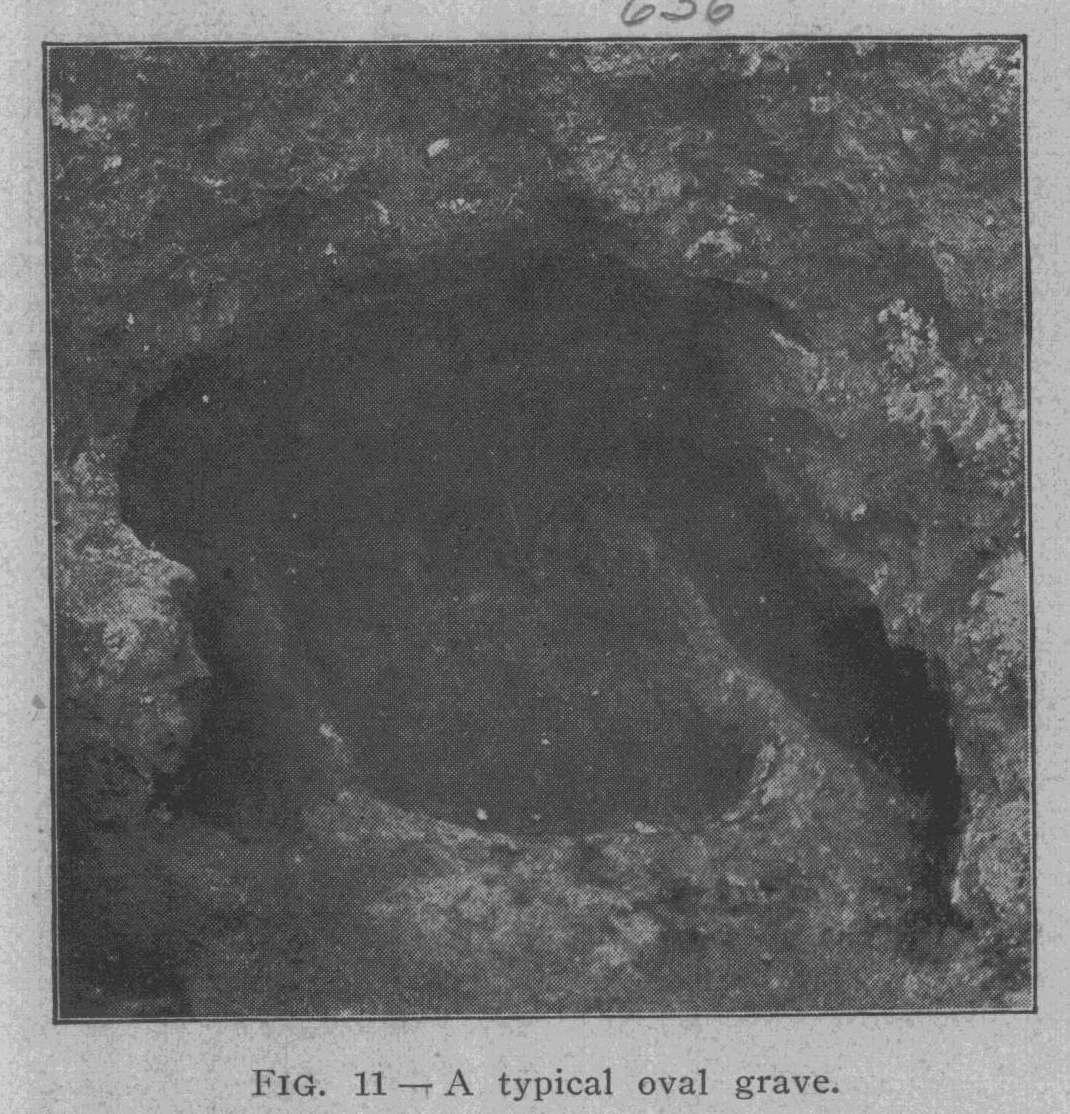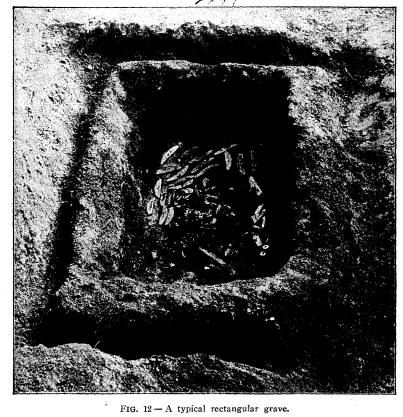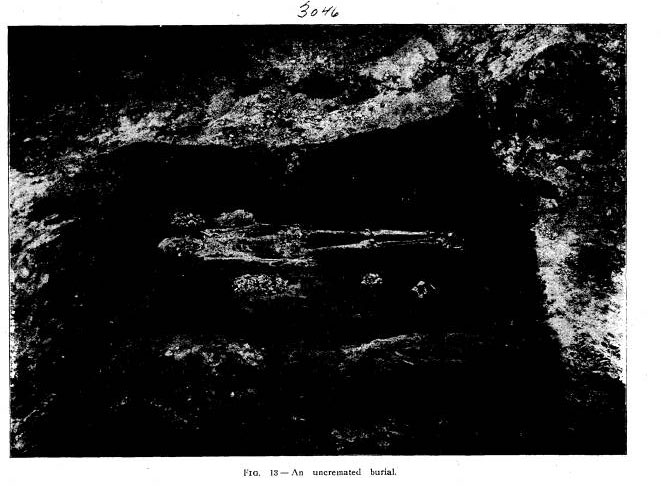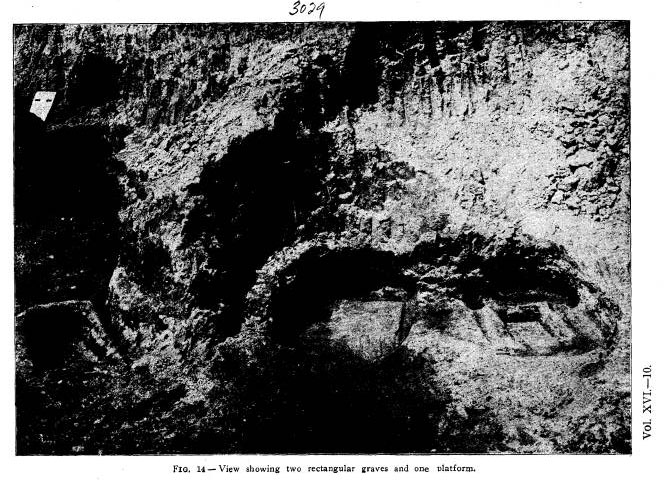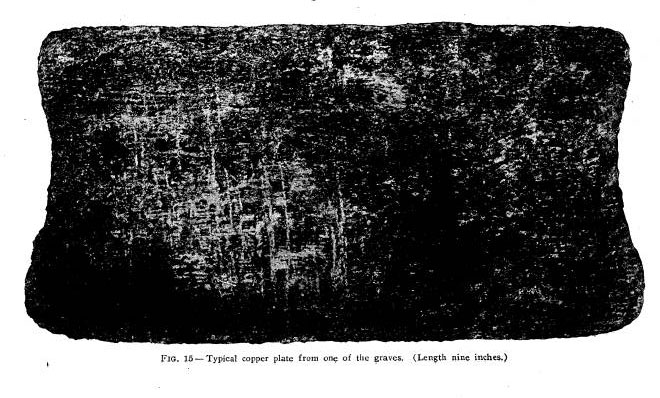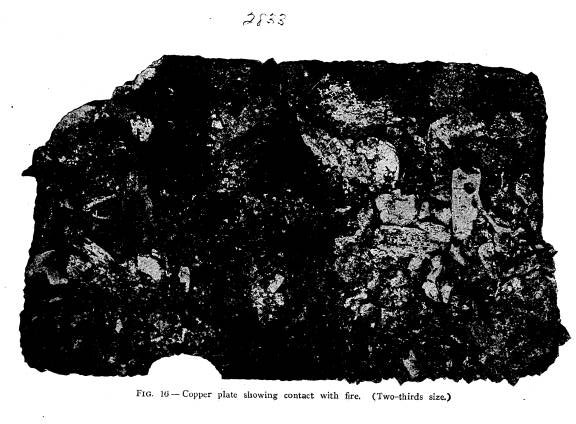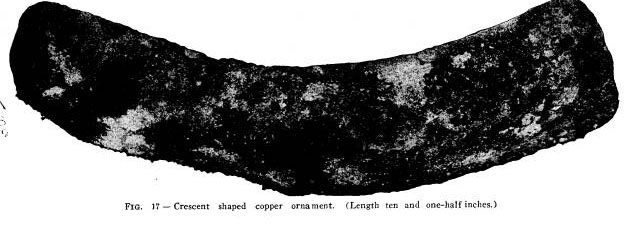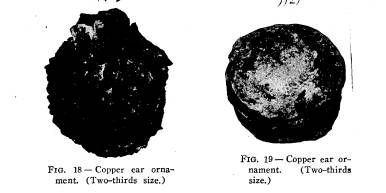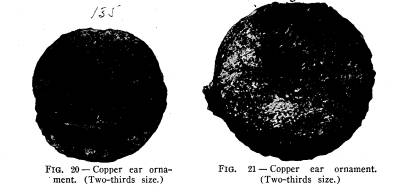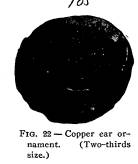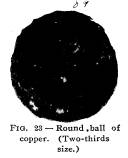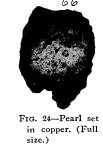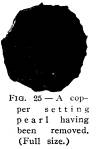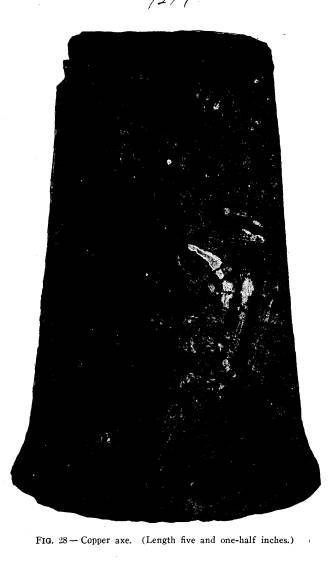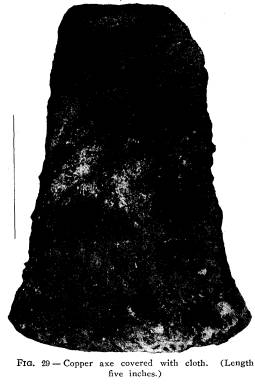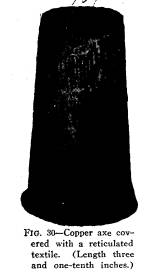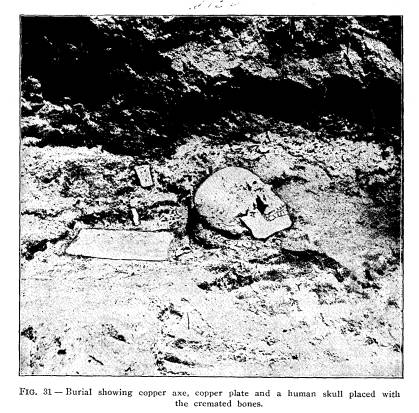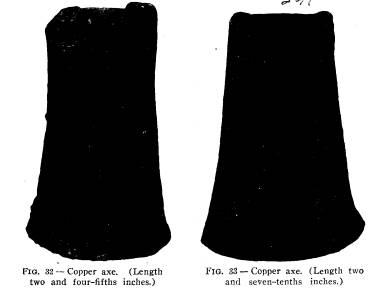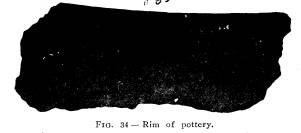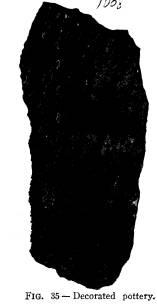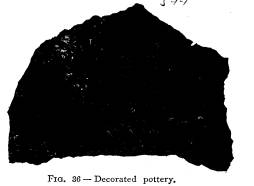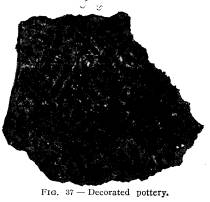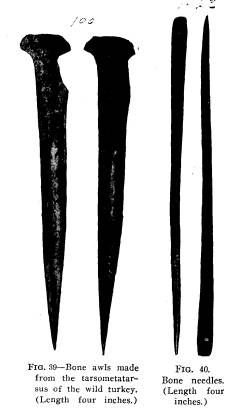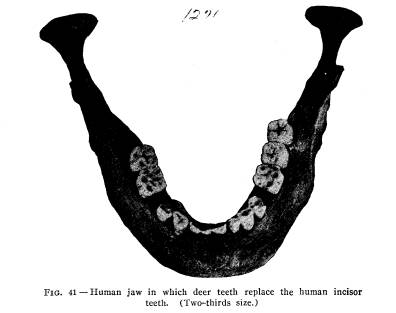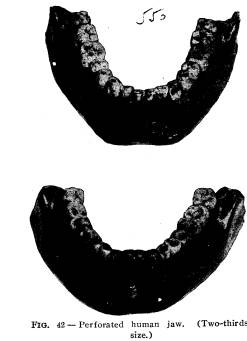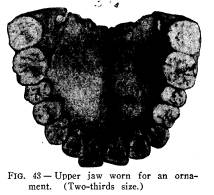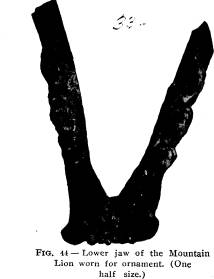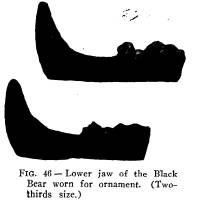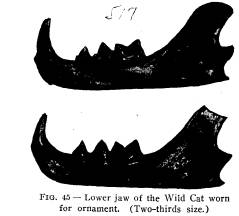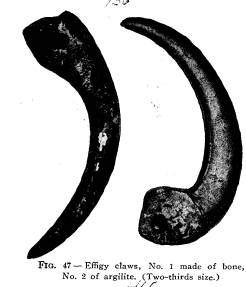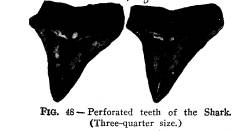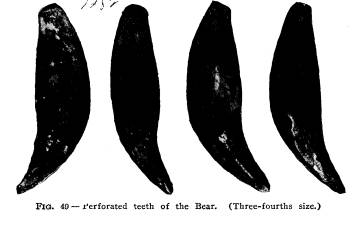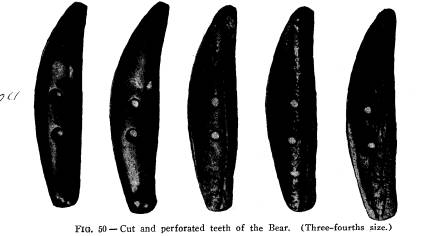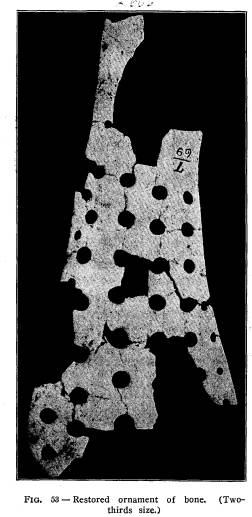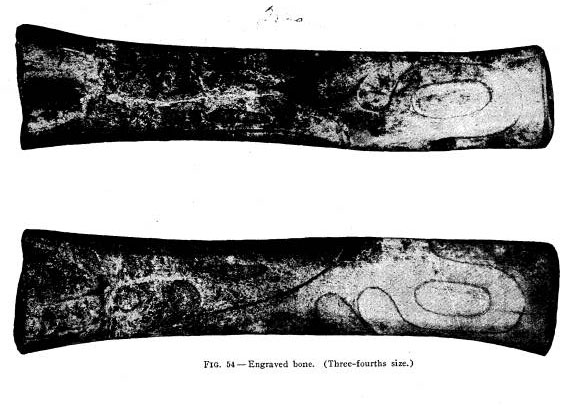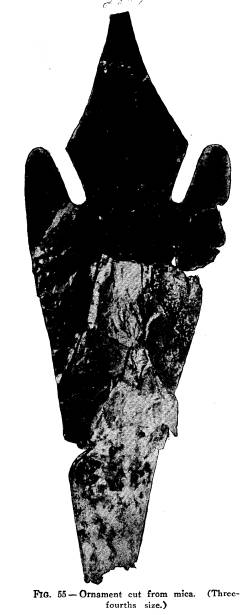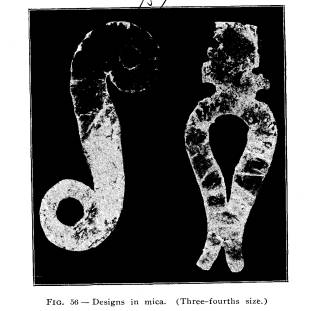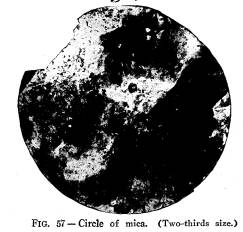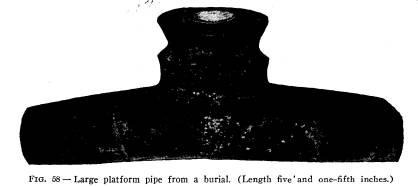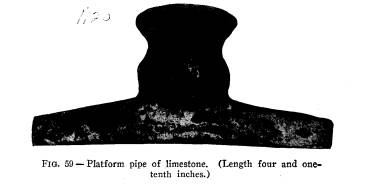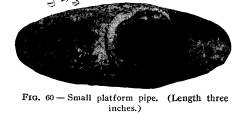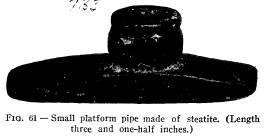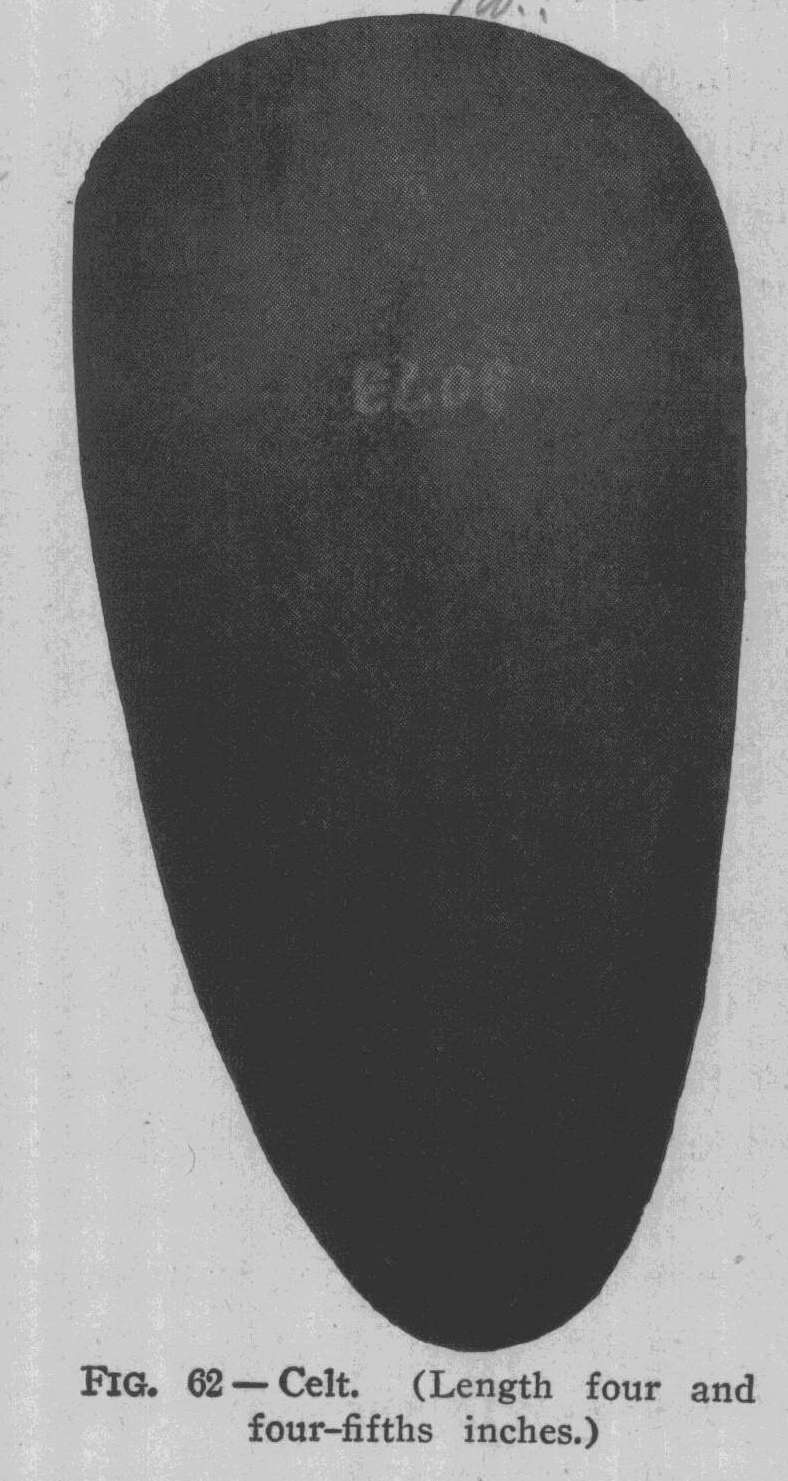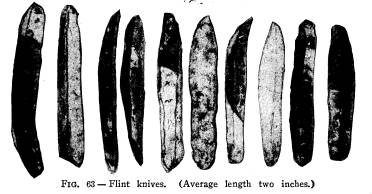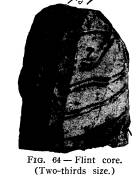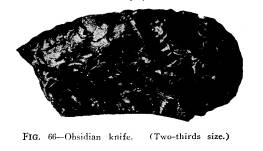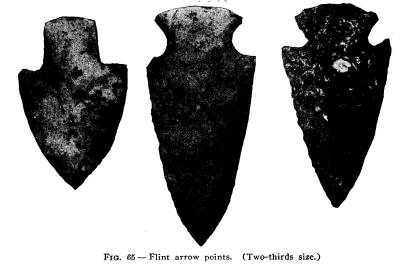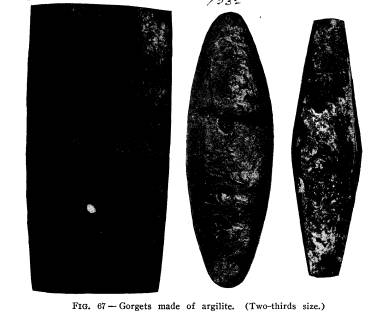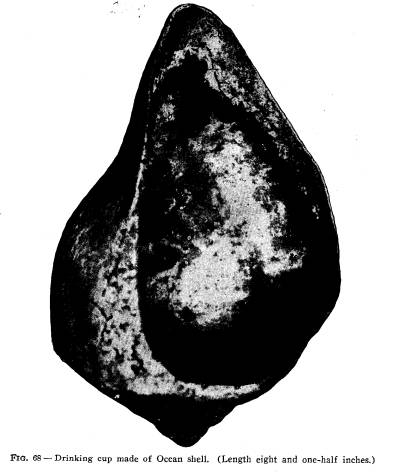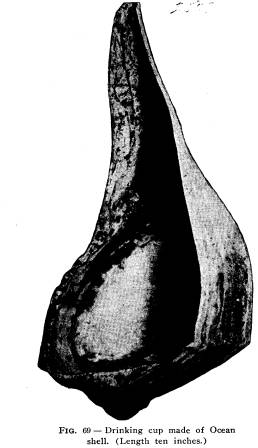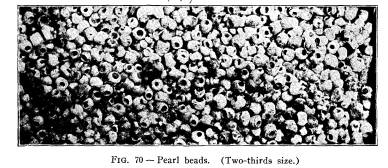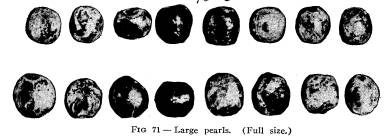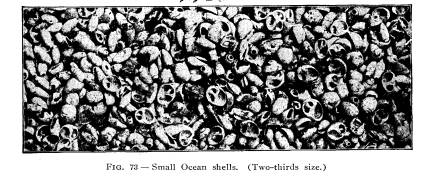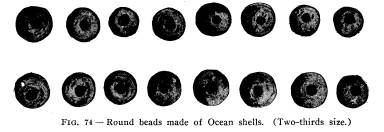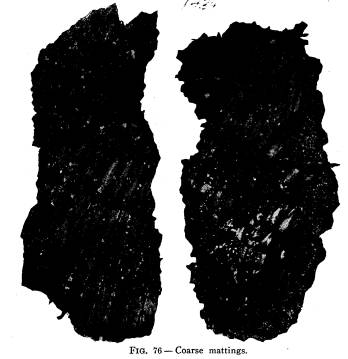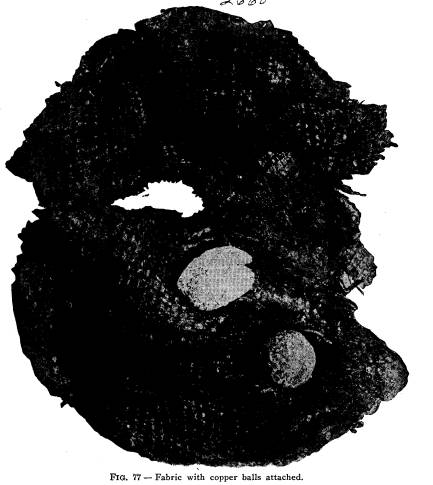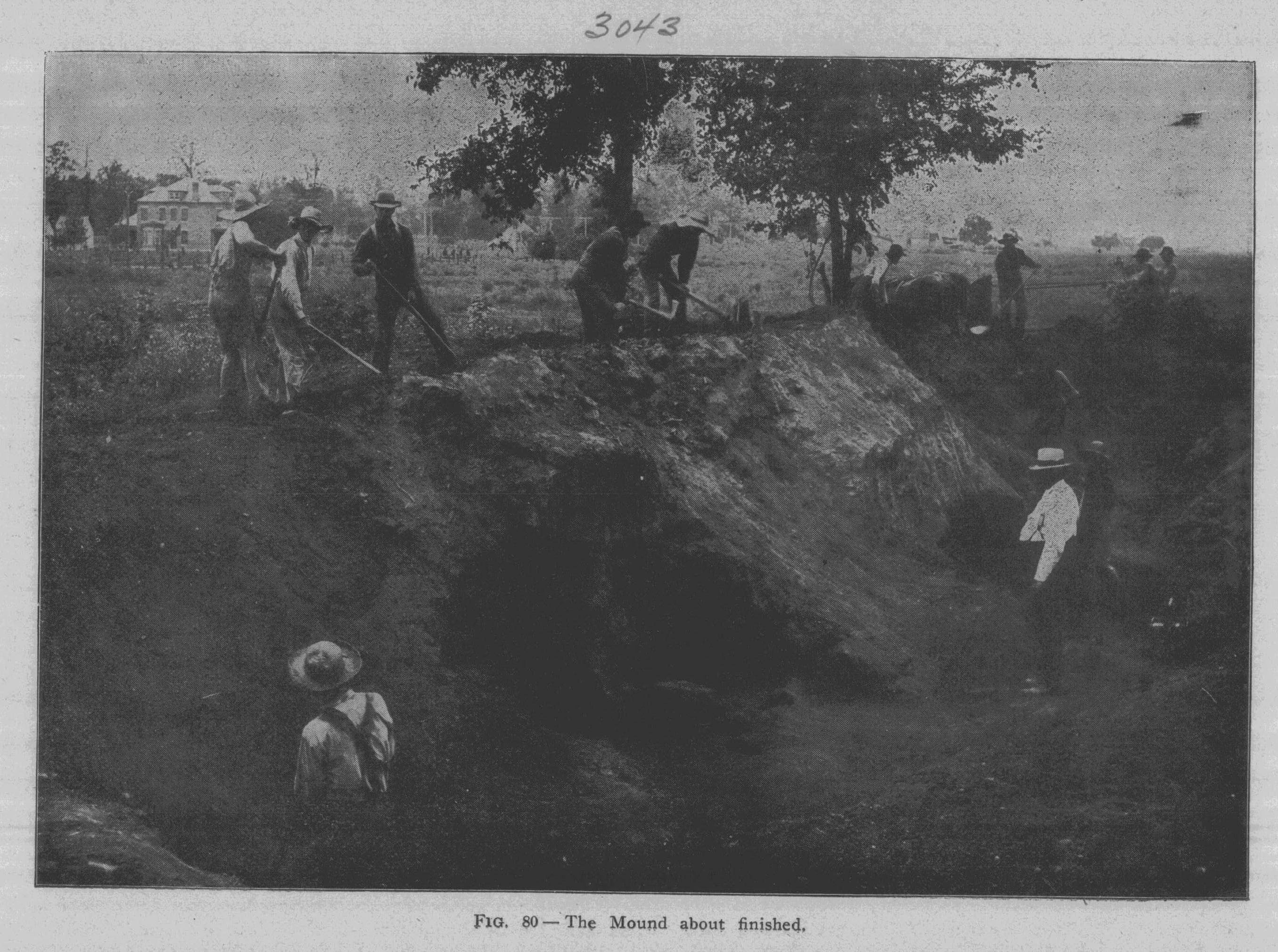Ohio History Journal
THE EXPLORATIONS OF
THE EDWIN HARNESS
MOUND.
WILLIAM C. MILLS.
The Edwin Harness Mound is the largest
of the four-
teen mounds which are located within the
earthworks of the
Harness groupl and in close
proximity to them, and it would
equal in dimensions more than all the
other mounds of this group
combined, and perhaps the largest mound
in the Scioto Valley
proper, although not equal in size to
the great Hopewell Mound,
located on the north fork of Paint Creek
and the Seip Mound
located in the western part of the
county along Paint Creek.
The Harness group, consisting of burial
mounds and a com-
bination of circles and a square, is
located in Liberty Township,
Ross County, Ohio, eight miles south of
Chillicothe, and is sit-
uated on the east bank of the Scioto
River and occupies the
third bottom and is fully a mile from
the present river channel.
Portions of the earthworks and the large
mound of the group
can be seen from the Chillicothe and
Richmondale Pike which
crosses the works directly in front of
the large mound.
The ground upon which the Harness group
is situated is
level, and the earth used in the
construction of the large mound
and of the earthworks was taken from the
surface in close prox-
imity to the earthworks.
Squier and Davis in their account give a
very good descrip-
tion of the appearance of the
earthworks, mounds and surround-
ings at the time of their survey, and
the following quotation is
from their published report.2 "The
walls of the entire work
are unaccompanied by a ditch, and are
slight, nowhere more
1Described by Squier and Davis as
"Ancient Works in Ross
County," on page 56 of
"Ancient Monuments of the Mississippi Valley."
2 "Ancient
Monuments of the Mississippi Valley," page 56, Squier
and Davis.
Vol. XVI.-8. (113)
114 Ohio Arch. and Hist.
Society Publications.
than four feet in height. The embankment
of the square is per-
ceptibly heavier than that of the small
circle, which is also
heavier than that of the larger one. The
square work measures
1,080 feet upon each side; and its walls
are interrupted at the
corner and upon the middle of each side
by gateways thirty feet
in width. The central gateways are each
covered by a small
mound, of about the same height with the
embankment, and
placed forty feet interior to it. The
manner in which the cir-
cular works are connected with the
square enclosure are accu-
rately shown in the plan, precluding the
necessity of a long and
intricate description. It will be
observed, that while the wall of
the larger circle is interrupted
throughout,- a feature for which
it is, of course, impossible to assign a
reason. Besides the small
mounds at the gateways, there are three
others within the works,
two of which are inconsiderable, while
the other is of the largest
size, being 160 feet long by not far
from 20 feet high. There
are also a few other mounds outside of
the walls, reference to
which is had elsewhere. Numerous dug holes occur in the
vicinity of the great mound. Most of
these are interior to the
works,-a very unusual circumstance. In
fact, the whole work
appears to have been but partially
finished, or constructed in
great haste. The mounds at the gateways
and those outside of
the walls are formed by carelessly
scooping up the earth at their
base, leaving irregular pits near them.
In most of the regular
works the material seems to have been
taken up evenly and
with great care or brought from a
distance.
"No one would be apt to ascribe a
defensive origin to this
work, yet it is difficult to conceive
for what other purpose a
structure of such dimensions, embracing
nearly one hundred
acres could have been designed. The
great mound is anomalous
in its character, and throws no light on
the question. That there
is some hidden significance, in the
first place in the irregularity,
and secondly in the arrangement of the
various parts, can hardly
be doubted. Nor can the coincidences
observable between this
and the other succeeding works of the
same series be wholly
accidental."
Mr. Gerard Fowke in his
"Archaeological History of Ohio"
Explorations of the Edwin Harness
Mound. 115
discusses at some length the
discrepancies in the surveys of
Squier and Davis.3
I have prepared a drawing of the works,
Fig. 1, following
the suggestions and corrections of Mr.
Fowke and have verified
his statements by a personal examination
of every portion of the
earthworks available.
Many changes have taken place since the
survey by Squier
and Davis. At that time almost the
entire works were covered
with the native forest, but now only a
part of the small circle
shows the original form as it was a half
century ago, and a
greater portion of the land has been
under cultivation for more
than a quarter of a century.
A railroad,- The Cincinnati, Hamilton
and Dayton,- has
cut through a portion of the earthworks
on the east side of the
pike, and Mr. Harness has built a large
house and barn on a
portion of the site of the small circle.
The land upon which the earthworks are
located was for-
merly owned by two brothers, Messrs.
Edwin and Daniel Har-
ness. The line separating their farms
extends almost east and
west about twenty-five feet south of the
large mound.
Since the survey by Mr. Fowke Mr. Daniel
Harness has
died. and his estate has been
apportioned among his heirs, and
Mr. Edwin Harness has divided his land
and the part now oc-
cupied by the greater portion of the
mounds and earthworks
belongs to his son, Mr. John M. Harness,
who aided in many
ways to make our examination of the
earthworks pleasant and
profitable.
THE EDWIN HARNESS MOUND.
The Edwin Harness mound has been a noted
one since the
early examination in 1846 by Squier and
Davis. During the last
half century many attempts to explore
the large structure have
been made by various institutions and by
private individuals,
and as a consequence the various
artifacts taken from the graves
of this mound are greatly scattered. The
specimens taken by
Squier and Davis during their
examination in 1846 are in the
Blackmore Museum, Salisbury, England.
Peabody Museum,
3"Archaeological History of
Ohio," by Gerard Fowke, page 184.
Explorations of the Edwin Harness
Mound. 117
Harvard University, contains some 278
recorded specimens taken
from this mound and the two small mounds
outside of the in-
closure, the results of the explorations
by Prof. F. W. Putnam
in 1885. Our own museum contains more
than 12,000 specimens
secured by the two expeditions sent into
the field by the Society,
the first in 1896, by Professor
Moorehead, who secured several
hundred specimens, and the last
expeditions by the writer in
1903 and 1905, when the remainder of the 12,000 specimens
were
secured and the examination of the mound
was completed.
Outside of the specimens accounted for
in the various mu-
seums of the country some four or five
private individuals, who
were school boys in the early fifties,
each have in their possession
from two to ten copper pieces taken from
the mound during
their school days,4 and at
one time there was scarcely a home in
the neighborhood that did not have from
one to a dozen artifacts
of various kinds from this mound, but
these specimens are now
so scattered that they will probably
never be recovered.
In the following pages I propose to give
a detailed account
of the final explorations of this mound,
and the recital would
not be complete without including all
the explorations made in
connection with this mound.
EXPLORATIONS BY SQUIER AND DAVIS.
Squier and Davis in their classification
of the mounds5 rec-
ognize four distinct features based upon
position, form, structure
and contents, and in this classification
they distinguish -
First -"Altar mounds which occur either within, or in the
immediate vicinity of the inclosures;
which are stratified, and
contain altars of burnt clay or stone;
and which are places of
sacrifice.
4The
school house is near and for years the school boys would
spend much time in digging holes into
the mound in search of relics,
and some of the most interesting
specimens were secured by these boys
as shown by the Report of Prof. Putnam
which will be noted in this
monograph.
5 "Ancient Monuments of the
Mississippi Valley," by Squier and
Davis, page 142.
Explorations of the Edwin Harness
Mound 119
Second - "Mounds
of sepulcher, which stand isolated or in
groups more or less removed from the
inclosure, which are not
stratified; which contain human remains;
and which were the
burial places and monuments of the dead.
Third- "Temple mounds which occur most usually within
but sometime without the walls of the
enclosure; which possess
great regularity of form; which contain
neither altars nor human
bones; and which are 'high places' for
the performance of reli-
gious rites and ceremonies, the site of
structure, or in some con-
nected with the superstitions of the
builders.
Fourth -"Anomalous mounds including mounds of obser-
vation and such as were applied to a
double purpose or of which
the design and objects are not apparent.
This division includes
all which do not clearly fall within the
three preceding classes."
Squier and Davis have placed the Harness
Mound in the
fourth class or anomalous mound group,
basing its classification
upon its form as being both a sepulchral
and an altar mound,
and I quote at some length concerning
their collections and finds:
"Besides the mounds already
described,6 the purpose of
which seem pretty clearly indicated,
there are many which will
admit of no classification. Some of them
possess features in
common with all classes, and seem to
have been appropriated to
a double purpose; while others, in our
present state of knowledge
concerning them, are entirely
inexplicable.
"As these mounds differ individually
from each other, it is
of course impossible to present anything
like a general view of
their character. We can therefore only
describe a few of the
more remarkable, dismissing the
remainder with the single obser-
vation that their features do not
indicate any specific design,
and are not sufficiently distinct or
uniform to justify or sustain a
classification.
"One of the most singular of these
mounds, and one which
best illustrates the remark that certain
mounds were probably
made to subserve a double purpose, is
situated within a large en-
closure on the east bank of the Scioto
river. A plan and section
of the mound are herewith presented
(Fig. 3). It is an irregu-
6 Squier and Davis "Ancient
Monuments of the Mississippi Valley,"
page 178.
|
120 Ohio Arch. and Hist. Society Publications.
lar oval in form, and is one hundred and sixty feet long, ninety broad at its larger end, and twenty feet in height. Excavations were made at the points indicated in the section. The one to- wards the right or smaller end of the mound disclosed an in- closure of timber, eight feet square, and similar, in all respects, to those found in the sepulchral mounds, except that, in this in- stance, posts eight inches in diameter had been planted at the outer corners, as if to sustain the structure. These posts had been inserted eighteen inches in the original level or floor of the mound. The holes left by their decay were found filled with |
|
|
|
decomposed material; when this was removed, they exhibited perfect casts of the timbers. The casts also of the horizontal timbers were well retained in the compact earth, and one of the workmen, without much difficulty, was enabled to creep more than half of the way around the enclosure which they had formed. Within this chamber the earth was as firm as in any portion of the mound. Upon removing a portion, a skeleton partly burned was found, and with it a thin copper plate seven inches long and four broad, perforated with two small holes; also a large pipe of bold outline, carved from a dark compact porphyry (Fig. 4). The bones seemed to have been enveloped in a species of matting, which was too much destroyed to be distinctly made out. The |
|
Explorations of the Edwin Harness Mound. 121
floor of the mound, it should be mentioned, as far as explored, was composed of clay, was perfectly level, and had been burned to considerable hardness. "The second excavation (B) was made in the larger end of the mound, somewhat to one side of the centre, at a spot marked by a depression in the surface. At the depth of twenty feet was found an altar of clay of exceeding symmetry. This was sunk, as shown in the section, in the general level or floor of the mound, and had been surrounded by an enclosure in all respects similar to the one above described, except that the timbers had been less in size. A fine carbonaceous deposit, resembling burned leaves, was found within the altar. Amongst the decayed mate- rials of the surrounding enclosure were found several skewers, if we may so term them, in lack of a better name, made of the |
|
|
|
bones (ulna) of the deer. They were finely tapered to a point, and had evidently been originally highly polished. Some were not less than nine or ten inches long. Though apparently sound, they were found to be exceedingly brittle, retaining little if any of their animal matter. Drifts were carried in the course shown in the section, and the evidences of another enclosure discovered. The excavation was suspended at this point, in consequence of heavy and continued rains. The holes soon became filled by the caving in of the loose earth near the surface; which discouraging circumstance, joined to the extreme difficulty of digging,7 pre-
7The difficulty of carrying on investigations in the large mounds cannot be appreciated. The earth is always so compact as to require, literally, to be cut out. It has then to be raised to the surface,- a |
122 Ohio Arch. and Hist.
Society Publications.
vented a resumption of the
investigation. It is very certain that
another, perhaps several other chambers
are concealed by this
mound.
"The surface of this mound was
covered with the layer of
pebbles and coarse gravel already
mentioned as characterizing
the mounds of the first class; but the
sand strata were absent.
Around the base had been laid, with some
degree of regularity,
a large quantity of flat stones,
constituting a sort of wall for the
better support of the earth. These
stones must have been brought
from the hills, which are here nearly
half a mile distant. Why
the altar as well as the skeleton had
been enclosed, and why the
floor of the mound had been carefully
leveled, cast over with clay,
and then hardened by fire, which will
probably remain unan-
swered and unexplained unless future
investigations serve further
to elucidate the mystery of the mounds.
At any rate, this singular
mound can prove no greater puzzle to the
reader than it has to
the authors of these inquiries."
EXPLORATIONS OF PROFESSOR PUTNAM.
In 1885 Professor F. W. Putnam, of
Harvard University,
examined a portion of the mound by
beginning a trench at the
north end and extending it with a
varying width, averaging about
18 feet at the top with a gradual slope
to the bottom. The trench
extended into the mound about one-third
of its length.
I quote at some length from Professor
Putnam's Report,8
as he includes an examination of several
small mounds outside
of the great earthworks and proves by
the contents of the smaller
that the builders belong to the peoples
who constructed the large
mound.
"Squier and Davis represent five
small mounds inside the
great square of twenty-seven acres.
These have been leveled by
cultivation, but we could trace the
outlines of three at least, one
task of great labor, and only
accomplished by leaving stages in the
descent and throwing the earth from one
to the other, and finally to
the surface. Four industrious men were
employed not less than ten
or twelve days in making the excavations
in this mound alone.
8 Eighteenth and Nineteenth Annual
Reports of the Peabody Mu-
seum, Vol. 3.
Explorations of the Edwin Harness
Mound. 123
of which we thoroughly examined, and
found that it had been a
simple mound of earth thrown up inside
of one of the 'gateways'
of the square. Three mounds, one twice
the size of the others,
are represented on the plan as just
outside one of the 'gateways'
on the eastern side of the great circle
of forty acres' area. All
three have been much reduced in height
by ploughing over them,
but probably only the superficial
portions have been disturbed.
These three mounds we examined with
care, and found that the
small one to the westward contained only
a small bed of ashes.
The other two proved to be burial mounds
of considerable in-
terest. The human bones were much
decayed. We found in
these mounds various objects made of
copper, stone, shell and
mica, of the same character as those
found in the large one of
the group, consisting of copper plates,
spool-shaped ear orna-
ments, a crescent-shaped ornament cut
out of slate, another small
stone ornament, a few large beads
covered with copper, and a
smaller one, covered with silver over
the copper, shell beads and
numerous other small articles.
"Another mound in the corn field,
north of the three above
mentioned, was also dug over completely.
"In this we found a large bed of
ashes and charcoal about at
the level of the natural surface upon
which the mound was made.
This ash bed covered nearly the whole
area occupied by the
mound, and in it we found many fragments
of pottery and cut
pieces of mica, some of which were
circular. A large piece of
grass matting and a mass of burnt seeds,
nuts and acorns, were
found in the bed of ashes. In one place
the charcoal matting
was in several layers, making a
thickness of an inch or more.
Near the centre of the mound, extending
to the south, was a
long, narrow pit, about nine by two
feet, which was a foot in
depth. At the bottom of this pit were
burnt stones, and over
them ashes and charcoal, fragments of
pottery and a few burnt
bones.
"Thus it will be seen that the
several mounds connected with
the extensive earthwork were erected for
different purposes and
vary considerable in their structure.
"Near the eastern corner of the
part of the earthwork which
we have called the 'great square,' and
within the line of the cir-
Explorations of the Edwin Harness
Mound. 125
cular embankment forming the 'great
circle,' stands the largest
mound of the group, which is known as
the 'Edwin Harness
Mound.' This mound proved to be of great
interest, and un-
like any other mound which we have
explored. It is 160 feet
long, from 80 to 90 feet wide and from
13 to 18 feet high along
the central portion, which rises
gradually from the southern to
the northern part. Up to this time we
have made a thorough
exploration of about one-quarter of the
mound, and have ascer-
tained that it is a burial mound of a
remarkable character. In
the northern portion, forty feet from
the center, we discovered
the first of the burial chambers, of
which we found a dozen in
all. These chambers were made by placing
logs, from five to six
inches in diameter, on the clay which
forms the lowest layer of
the mound, in such a way as to make
enclosures six to seven feet
in length, and from two to three in
width, and about a foot in
height. In these the bodies were placed,
evidently wrapped in
garments, as indicated by the charred
cloth and mats found in
several of the chambers. With the bodies
were buried various
objects, such as copper plates,
ear-rings, shell beads, and, in one
instance, long knives chipped from
flint. In two instances, the
skeletons were found extended at full
length within the cham-
bers, the outlines of which could be
traced by the imprint of the
logs in the clay, the logs themselves
having decayed, leaving only
a dark dust. On the breast of one of the
skeletons was a thin
copper plate or ornament. The chemical
action of the copper had
preserved the texture of the finely
woven cloth lying between the
plate and the bones of the chest. In
other chambers, the bodies
had been burned on the spot, as
conclusively shown by the rela-
tive positions of the bones, and the
fact that, in two instances,
portions of the body had fallen outside
of the fire and escaped
burning. It became evident, as our
explorations progressed, that
these chambers were covered by little
mounds of gravel and clay,
and that, in those where the burning had
taken place, the cov-
erings of earth were placed in position
before the bodies were
consumed, shown by the small amount of
ashes and the reduction
of the logs to charcoal in their
position on the clay floor of the
chamber, which was burned to a thickness
varying with the
amount of heat. It is probable that the
burials and cremations
126 Ohio Arch. and Hist.
Society Publications.
did not occur at one time, and that,
after all these mounds had
been made, earth was brought from
various surrounding places
and heaped over all. Then the mound was
finished with a cover-
ing of gravel and a low border of loose
stones was placed around
its base.
"It is of interest to note that
Squier and Davis, in 1840, dug
two pits in this mound. At the bottom of
their pit A, which was
just south of the center of the mound,
they opened one of the
burial chambers, and they state that the
skeleton in it was partly
burned, that it was enclosed in a
framework of logs, and that
with it were a copper plate and a pipe
carved out of stone. They
remark that the body seemed to have been
enveloped in matting.
Their pit B, about twenty feet northwest
of the centre, and there
they came to another burnt skeleton, as
shown by their explora-
tion, although, deceived by the
imperfect examination which the
caving of the pit compelled them to
make, they thought they
had found an 'altar,' and mention the
burnt burial chamber as
such. They state that they found at this
point several imple-
ments made of bone. At the side of their
excavation we took
out about half a dozen pointed
implements made from the leg
bones of deer. Several months before our
work was begun, as
already referred to, the school boys,
under the lead of Mr. Wil-
son, dug two pits in the mound, one of
which was between those
made by Squier and Davis over forty
years ago, and the other
at the side of Squier and Davis' pit B.
In each of these many
remarkable objects were found. So far as
'relics' are concerned,
the boys made a lucky hit and took out
more objects from one
of their pits than were found in all our
explorations. The larger
part of these we have been able to
secure from the boys, and
from Mr. Daniel R. Harness, who very
kindly gave to the Pea-
body Museum all that he had purchased
from the boys at the
time, realizing that they would be of
more importance and value
to science if placed in the museum with
other objects from the
mound, than if held in private hands as
mere curiosities. Among
the specimens thus obtained were two
copper celts and three or
four copper plates, also several copper
ear ornaments, some of
which were covered with meteoric iron in
the same way as those
from the Turner Mounds in the Little
Miami Valley, and a celt
Explorations of the Edwin Harness
Mound. 127
made of meteoric iron. Thus we have an
important link, con-
necting the people who built this great
mound and the earth-
works about it in the Scioto Valley,
with the builders of the sin-
gular group on the Turner farm, in the
Little Miami Valley.
"Burnt human, animal and bird
bones; shells of different
kinds, some of them perforated; cores
and chipped points of
flint; ornaments made of stone;
hammer-stone and discoidal
stone; beads of pearl, bone and shell;
canine teeth of large bears,
some of them perforated; teeth of deer
and a shark's tooth; orna-
ments made of copper; ear ornaments of
copper, a few covered
with a thin layer of silver and others
with meteoric iron; small
hemispheres of stone and of pottery,
covered with silver, copper
and meteoric iron; fragments of silver
ornaments; a celt of mete-
oric iron and one of copper; ornaments
and fragments of mica;
portions of a pipe carved out of stone;
a large mass of galena;
cloth, seeds, nuts, corn and grass, all
charred; fragments of mat-
ting partly burnt; balls of clay;
fragments of pottery; bone han-
dles, awl points and other implements of
bone; braided grass;
charcoal, ashes and burnt clay, some of
the latter still bearing the
impress of logs of wood; portions of
burnt and unburnt human
skeletons; all from the mounds belonging
to the Liberty group
on the land of Edwin Harness, Esq., in
Liberty Township, Ross
County, Ohio."
EXPLORATIONS OF PROFESSOR MOOREHEAD.
In 1896 Professor Warren K. Moorehead,
under the aus-
pices of the Ohio Archaeological and
Historical Society, ex-
amined the south part of the mound,
beginning where Professor
Putnam left off. His examinations were
for the most part car-
ried on by means of tunnels, and I quote
from his report:9
"Our work upon the mound was begun
July 22d and
ended the evening of August 9th.
We first cleaned out the end
of the trench abandoned by Professor
Putnam, and measuring
the mound thence to its end, ascertained
the distance to be about
eighty feet, at least sixty feet of
which should be excavated. We
9 Publications of the Ohio State
Archaeological and Historical So-
ciety, Volume 5.
Explorations of the Edwin Harness
Mound. 129
started in with a trench some thirty
feet in width, being a little
wider than the excavation he had
conducted. We had proceeded
twelve or fifteen feet when we
ascertained that burials followed
each other pretty much the same distance
apart on either side of
the mound, and that there were few
burials in the main or central
portion. Most of the burials in these
rows occupied little domes
or pits, varying from three to five feet
in diameter and three to
five feet in height.
"We decided to explore the mound by
means of tunnels,
which should follow the lines of the
burial, and, at short distances,
to run side branches from the main
tunnels toward the center,
and, if necessary, toward the edges of
the mound. As the work
proceeded the scheme was found to be
practical, and the whole
base of the mound was thoroughly covered
at much less expense
than would have resulted had we
attempted to remove the entire
structure. The total length of tunnels
and branches was 253
feet, the main tunnels 98 feet, the
branches 155 feet. It occupied
the time of from four to five men
continuously for sixteen days.
They were five feet wide at the base and
about four and one-
half feet high.
"In the end of the mound opened by
Professor Putnam a
number of entire skeletons were found,
accompanied by various
objects. In the end which we explored
were a total of twenty-
seven interments, but two of which were
uncremated skeletons,
a child and an adult. All the others
were more or less burnt.
In Fig. XVII all skeletons with which
relics were found are
numbered, and the brief description
accompanying the illustra-
tion will acquaint readers with the
find. Skeletons Nos. 4 and 5
had some of the copper objects with
them. No. 10 had the best
copper plate. Eight of the bodies had
objects buried with them.
Every one of these skeletons had been
cremated, and even some
of the beads and copper showed marks of
fire. The total inter-
ments in the mound numbered 27.
"Nearly all of the skeletons were
on little raised platforms
of burnt earth, varying in height from
four to ten inches. The
platforms were usually about two by
three feet. Such relics as
accompanied the remains were placed in
no special order and
many of them were partly burnt up. The
looseness of the earth
Vol. XVI.-9.
130
Ohio Arch. and Hist. Society Publications.
above the skeletons, or the little domes
to which we have referred,
is probably due to small structures of
poles having been built
about the remains. The supports remained
in position sufficiently
long for the earth to become somewhat
packed, and after their
decay just enough earth fell upon the
remains to cover them
loosely. Frequently there was a space of
about a foot between
the top of the dome and the loose earth
below. The good cop-
per plate found in No. 10 is nine inches
long and five inches wide.
It had two small perforations. With No.
5 was a burnt plate,
three-fourths of which we took out
entire, beads and bear
tusks, etc.
"The skeleton uncremated (and
placed by itself) was found
as indicated by No. 12 in Fig. XVII.
These individual inter-
ments, at a distance or isolated from
the other burials, are often
observed in the large mounds of the
Scioto.
"In the heavy layer of charcoal and
carbonized wood ac-
companying skeletons Nos. 7 and 3, were
fragments of cloth,
which we preserved in order that the
texture and manner of weav-
ing might be carefully studied."
FINAL EXPLORATIONS.
On the 14th of August, 1903, I commenced
the final explo-
rations of the mound, by exposing to
view from time to time as
the work progressed, the entire site of
the mound, recording and
photographing the burials and other
important features of the
mound.
The mound at the time work was begun,
was covered with
a dense tangle of underbrush and trees
(See Frontispiece). A
deep cut beginning at the north end of
the mound extended almost
to the center, while dug holes extending
down to the tunnels
below made the place very unsightly, and
to say the least, not very
promising of results.
After the underbrush and trees were
removed the surface
of the mound was examined and measured.
The results of the
measurements are as follows: Length of
mound, 160 feet; width
of mound, at the north end, 85 feet; at
the south end, 70 feet,
with a height of 163/4 feet at the north
end, which gradually tap-
132 Ohio Arch. and Hist.
Society Publications.
ered to 11 1/4 at the south end,
the mound containing approxi-
mately 4,700 cubic yards of earth.
The mound for the most part was
constructed of loam or
surface soil, secured in close proximity
to the mound, however,
a hard, compact clay, overlying the
gravel, and which clay is
found to a depth averaging from 3 to 4�
feet, and which was
used in constructing nearly all the well
prepared graves, which
latter will be described at some length
later on, was also used.
The clay used in covering the graves
would average in thick-
ness from a few inches to fourteen
inches and was secured from
deep holes which are quite noticeable a
few hundred feet east and
north of the mound.
The flat stones described by Squier and
Davis as placed upon
the sides of the mound were found at
three different points upon
the mound. At the west end of the mound
stones were found ex-
tending up the side of the mound to the
height of about six feet.
These stones consisted of slabs of
sanstone averaging in length
from a few inches to several feet, and
in thickness from one to
four inches. These had been laid with
some degree of regularity
and placed upon the mound in the form of
a circle forty feet in
diameter, the highest point being near
the center of the mound,
and then gradually tapering toward each
end. On the east side,
two of these circles were present, one
near each end of the mound.
The stones on the east side were
different in size, none of them
being large, and all less than a foot in
length, averaging in thick-
ness from one-half to one inch. The
greater number of these
flat stones showed use as a digging
implement, and were no doubt
employed in digging the soil used in the
preparation of the graves
and the building of the mound.
SPECIAL FEATURES OF THE INTERIOR OF THE
MOUND.
Many interesting features were brought
to light in the ex-
amination of the mound.
First. The object of the mound was for
burial purposes
only.
Second. The site of the mound was an
enclosure consisting
of large posts placed in the ground to
the depth of two and one-
Explorations of the Edwin Harness
Mound. 133
half to three feet, as evidenced by the
post molds; the posts hav-
ing been burned off to the surface of
the ground when the char-
nel house was filled and ready for the
mound to be heaped
over all.
Third. All the burials in the mound had
graves carefully
prepared for the reception of the dead.
Fourth. The burials were of two kinds,
cremated and un-
cremated.
Fifth. The cremation for the most part
took place away
from the grave and the ashes and charred
bones of the deceased
were gathered together and placed in the
prepared grave, though
a few bodies were evidently cremated at
the grave.
Sixth. A final ceremony was performed
when the cremated
dead were placed in the grave. The
uncremated dead were placed
in graves similar to those for the
cremated.
Seventh. The builders of this mound were
representatives
of the highest culture of the aboriginal
man found in Ohio.
I shall attempt in the following pages
to discuss all the
special features of the mound, including
a detailed account of
the artifacts taken from the graves.
THE OBJECT OF THE MOUND.
Squier and Davis in their discussion of
this mound, previ-
ously referred to, describe it as an
anomalous mound, namely,
that it was used for a double purpose
and describe that double
purpose as a sepulcher and altar mound.
In my examination of
the mound I was fortunate in finding the
shaft B which Squier
and Davis describe and figure, and is
reproduced in Fig. 3 of
this article.
Professor Putnam states that he took
from the side of the
excavations half a dozen of the large
bone implements made from
the leg of the deer. These were
described by Squier and Davis
as the "skewers" found in the
altar enclosure.
I cleaned out the shaft made by Squier
and Davis and found
the grave described as an altar, but it
was similar in every re-
spect to the hundred or more other
graves found in the same
mound. The charred remains of the
cremated dead were re-
maining in the grave, but had been
greatly disturbed, and four
134 Ohio Arch. and Hist. Society Publications.
more of the large bone implements, one
large perforated canine
of the bear and two copper ear ornaments
were left in the grave.
One of the most interesting features of
this grave was the
finding of a large number of bone
implements stuck in the clay
layer which immediately covered the
grave. All of these imple-
ments were so placed as to point toward
the center of the grave,
and twenty-six were taken out in a
perfect condition, while in-
numerable pieces of these implements
were found in the loose
dirt which had been handled by Prof.
Putnam, so there is no way
of telling how many of these artifacts
were placed with this
burial, and was the only instance in
which the large bone imple-
ments, made from the metapodiale bone of
the deer and elk, were
found in the entire mound.
One of the conditions, according to
Squier and Davis, char-
acterizing the altar or sacrificial
mound is a stratification of the
different soils, but this condition
occurs practically in all mounds,
and this change in the earth was easily
discerned whenever the
sides of the mound were sufficiently
exposed. This stratification
was caused by a variation in the soil as
it was taken from its
original bed and placed upon the mound.
When the gravel, or in
some cases sand, was encountered it was
placed over the mound,
and at various places in this mound the
gravel was several inches
thick and seriously annoyed the workmen.
At the Seip Mound, on Paint Creek, a
layer of gravel, in
some places thirty inches in thickness,
was encountered, so that
I fear it would be impossible to
characterize a mound as being
stratified to signify a certain definite
type, for all mounds show
different layers caused by a difference
in the soil.
It seems probable that Squier and Davis
imagined that in the
two burials, or as they characterized
them, a burial and an altar,
they had secured about all the great
mound revealed, though
they said, "It is very certain that
another, perhaps several other
chambers, are concealed by this
mound."
Professor Putnam in his investigations
removed twelve
burials, two of which were uncremated
and ten cremated.
Professor Moorehead secured twenty-seven
burials, of which
twenty-five were cremated and two
uncremated, and our present
investigation secured one hundred and
thirty-three burials. Five
136 Ohio Arch. and Hist.
Society Publications.
were uncremated and one hundred and
twenty-eight cremated,
which shows a total taken from this
mound of ten uncremated
and one hundred and sixty-four cremated,
still it is known that
quite a number were destroyed by the
school children in their
search for relics, as Professor Putnam
states that the school chil-
dren secured more relics from one pit
than he secured in all their
explorations, hence it is safe to say
that at least ten graves
were destroyed in this way. Therefore it
seems to me that this
mound must be considered purely as a
burial mound; that no
altars occurred in the mound; that all
burials had prepared
graves; that for the most part cremation
took place at the charnel
house where eight great fire places were
found, which were per-
fectly devoid of ashes except in one,
where a small charred piece
of human skull was found, thus
indicating that these fire places
were used for the crematory. After the
cremation took place
the ashes and charred bones were
gathered together and placed
in a grave near by. In a number of
instances the cremation took
place at the grave. These are all
characterized by finding por-
tions of the unburnt skeleton intact.
The uncremated were placed
in regular order with the cremated, and
in no instance were two
uncremated burials side and side, but
were invariably followed
by a cremated burial.
CHARNEL HOUSE.
The site of the great mound had been
properly prepared and
its beginning was at the south end of
the mound, marked by
large posts set in the ground at a depth
varying from two and
one-half to three feet. The south end of
the enclosure was made
in the form of a semicircle, and the
sides continuing in a straight
line north for sixty feet, when the line
of posts was turned at
right angles to the east wall and
running across toward the west
side, where an opening was left for an
entrance. This enclosure
of sixty feet in length measuring, from
the center of the circle
on the south to the row of posts running
across the mound at
right angles to the outside walls, forty
feet in width at the north
end, was no doubt the first structure or
enclosure for the recep-
tion of the dead.
The second enclosure was merely a
continuation of the out-
Explorations of the Edwin Harness
Mound. 137
side walls of the first, extending some
seventy feet directly to the
north, when another wall at right angles
to the east wall was
run directly to the west, and similar in
every respect to the open-
ing at the south part of the mound;
however, the posts were not
in a straight line in the north section
of the mound, and the inside
of the mound at the north end measured
fifty-one feet. It is im-
possible to tell whether the two
enclosures were built at the same
time or not, but I am inclined to
believe from a careful observa-
tion, that the portion to the north was
not constructed until the
south portion had been filled with the
dead, though I feel assured
that the south portion was not
completed, and a mound heaped
over it until the north portion had been
also filled and the entire
site was ready for the building of the
great monument.
On the interior of the mound at
irregular points large post
molds were found, and in the north
section of the mound one of
these posts extended above the floor of
the mound a few inches
more than ten feet, indicating that
perhaps other posts, as evi-
denced by the post mold, extended above
the graves, and there-
fore might have supported a covering or
roof for the charnel
house.
I am inclined to believe that such a
roof existed, although no
definite proofs of such a roof, other
than the uprights to support
it, were found in the mound. The posts
forming the outer row
varied in size from six to ten inches,
however, a very great num-
ber of the upright supports consisted of
a combination of smaller
posts placed together, and this was
evidenced by the post molds
showing a number of smaller posts placed
together. In a num-
ber of instances these posts had been
split, and in several cases
posts seven inches in diameter were
split and used for support.
After the posts were placed in position
the base of the mound
was carefully prepared by the formation
of a clay floor which
gave great evidence of having been
puddled before being placed
in position. This clay floor extended
from a few to fifteen inches
beyond the posts on the outside of the
enclosure. After the floor
had been carefully prepared there was
placed over it a layer of
fine sand, varying in thickness from
one-half to three quarters
of an inch, and so compact was this sand
at the time of our ex-
amination that where it was the thickest
it could be taken out in
138 Ohio Arch. and Hist.
Society Publications.
large slabs. The clay floor was also dug
up by us and examined
from one end of the mound to the other.
This floor varied in
thickness. In some places it was only
three or four inches in
thickness, in other places from ten to
twelve. This, like the sand
layer, could be taken out at the time of
examination in great
blocks, as the original surface of the
site was covered with ashes
and charcoal which readily separated the
clay floor from the
original surface, and showed that the
site had been carefully
cleaned of all debris by burning.
Nowhere were there evidences
of any prolonged fire on the original
surface, rather only the
burning of small limbs as was evidenced
by the charcoal remains.
After the charnel house was filled with
the dead, the final prepa-
ration for the erection of the mound was
completed by burning
off the superstructure and exposing to
view the graves as they
had from time to time been made.
We know that the graves were covered
before the super-
structure was destroyed as the covering
of many of them, which
were placed near the outer row of posts,
extended around these
posts, and when the superstructure was
burned the charred re-
mains of the top of the posts were three
and four inches and
sometimes more, above the other posts
which were not so covered.
The charred tops of the posts were
always present, these were
never destroyed, but the portions of the
posts that extended into
the base below had entirely rotted away,
leaving the exact mold
of the post. Very frequently these molds
would contain broken
animal bones, mussel shells and
occasionally a piece of mica, but
we have never been able to find, in the
great number of molds
examined, any implements or ornaments.
BURIALS.
All the burials, whether cremated or
uncremated, were placed
in a prepared grave and great care and
some degree of skill was
displayed in their construction. The
graves of the cremated were
similar to each other so far as the
outside construction was con-
cerned, but unlike in the general make
up of the inside of the
grave. Out of one hundred and
twenty-eight graves unearthed,
Explorations of the Edwin Harness
Mound. 139
four different types10 were
found, and these were many times
duplicated during the explorations.
First. The plain elevated platform made
of clay and usu-
ally elevated from three to six inches
above the prepared plat-
form. In a number of graves this clay
had the appearance of
being puddled and then used in
constructing the platform, while
in other cases the clay did not have
that appearance, but seemed
to have been used in making the platform
in the dry state. This
plain elevated platform grave was
invariably higher at the center,
gradually sloping to the sides and ends
where small logs, aver-
aging in diameter from three to six
inches had been placed, usu-
ally in the form of a parallelogram, but
often very nearly in a
square. These plain platforms averaged
in length about four
feet and in width two and one-half to
three feet. The logs were
usually made the exact size of the
graves. In a few instances they
extended over at one end or the other,
and not a single grave was
found on the base of this entire mound
that did not show the
use of logs as an outline for the grave.
In many instances the
logs were put in place upon the platform
and plastered over with
this clay,and then the inside of the
grave was made. Fig. 9 is a
good illustration of the prepared grave
of the plain platform type.
Second. The next type of grave was
similar to the first and
apparently made in the same way, with
this difference: the top
of the platform was cut out and made in
the form of a basin,
varying in depth at the center from two
to four inches. A good
illustration of this platform is shown
in Fig. 10.
Third. Elliptical shaped grave. In this
form of grave the
platform was similar to the other
graves, but the timber used in
the construction of the outside portion
was made of small pieces
of logs and the clay plastered over
them, forming a regular ellip-
tical grave. This type is shown in Fig.
11. This form of grave
10The four types of graves mentioned
above were similar in every
respect to the altars described by
Squier and Davis, and I quote from
"Ancient Monuments of the
Mississippi Valley," page 143 as follows.
"The altars or basins found in
these mounds are almost invariable of
burned clay though a few of stone have been discovered.
They are symmetrical but not of uniform
size and shape, some are
round, others elliptical and others
square or parallelogram."
|
140 Ohio Arch. and Hist. Society Publications. would vary in depth from four to eight inches; and required much skill and labor in its construction. |
|
|
|
trated in Fig. 12, which shows one of the graves and its contents. |
|
|
|
cremated remains for the most part were brought to the grave, the cremation of the body taking place away from the grave, and |
|
Explorations of the Edwin Harness Mound. 141
as previously stated, I have great reason to believe that the cre- mation took place at the eight great fire-places found within the charnel house. In only one was there left anything to show for what purpose these great fire-places were intended. In the one in question a portion of a human skull was found, indicat- ing that the cremation took place after which the remains were gathered up and removed to the grave. In all of the other great fire-places found, not even a small amount of ashes could be se- cured, as all had been gathered and carried away, though a num- ber of the bodies were undoubtedly cremated at the grave. |
|
|
|
be cremated. In all of the graves where cremation took place at the grave a portion of the fleshy part of the body would not be wholly destroyed, consequently the innominate and parts of the femur would be in place while the other portions would be de- stroyed. One of the singular features of the cremations which took place at the grave was that the implements and ornaments would be almost totally destroyed, while in the cremations which took place away from the graves the implements and ornaments were placed in the grave in a perfect state with the ashes and the incinerated bones of the body. After these remains were de- posited in the grave they were frequently covered over with mat- |
|
142 Ohio Arch. and Hist. Society Publications.
ting or some woven fabric, and then a covering of grass and twigs, and as a last ceremony this covering was set on fire, and while it was thus burning clay was carried and covered over the fire, thus preserving the cloth, the grass and twigs in a charred state. The covering of these graves, as heretofore stated, was of |
|
|
|
clay similar in every respect to the clay used in making the plat- form and in forming the grave. This covering of clay would vary in thickness from a few inches to fourteen inches, the average being very close to ten inches, and was the temporary covering for all the graves as they were placed in the charnel house. The uncremated graves were prepared in the same way as |
144 Ohio Arch. and Hist.
Society Publications.
shown in the illustration, Fig. 13. This
individual was placed
in the grave at full length, with him
were ornaments of copper,
such as the ear ornaments, which can be
seen at the side of the
head, and a great copper plate which is
under the loins. The
ornaments are similar to those found in
the cremated graves.
On the right hand side of the body, as
it lay in the grave, was
placed the incinerated remains of an
adult, on the left hand was
a human skull, and near the head on the
left side of the body,
was placed another cremated skeleton;
near the knees on the
right side of the body, was placed the
skeleton of a little child,
and near this skeleton were two human
jaws, perforated, and
which no doubt had been used for
ornament..
ARTIFACTS FOUND WITH THE BURIALS.
The articles taken from the burials of
this mound were most
interesting as to quantity and quality
and represent the highest
art of prehistoric man in Ohio. From the
133 burials, upwards
of 12,000 specimens, including implements
and ornaments of cop-
per, shell, bone and stone were removed.
Some of the copper
pieces contained small nuggets of
silver, showing that the copper
came from the Lake Superior region.
Large ocean shells that
were made into drinking cups and
ornaments of various kinds
were unearthed, which came evidently
from the region of the
southern gulf. There were also found
great quantities of mica,
some pieces representing the original
blocks as they were quar-
ried, other pieces had been cut into
geometrical forms and used
for decoration. This mica no doubt came
from North Carolina.
Again we found crystals of galenite as
well as large lumps of the
lead ore, which came from the north
Illinois region. Obsidian
was also found, and this no doubt came
from the far west, per-
haps the Yellowstone region. The finding
of so much material
of this sort, whose source of supply was
so far from the site of
the mound, indicates that the
prehistoric inhabitants of this sec-
tion had an inter-tribal trade, for it
certainly would have been
impossible for the Ohio tribes to visit
those distant points men-
tioned.
The artifacts were made into various
forms of implements
and ornaments. The most interesting of
these are the large cop-
146 Ohio Arch. and Hist.
Society Publications.
per plates of which ten were found, the
largest one being ten
inches in length by five and one-half
inches broad. It was made
of very thin copper one-eighth of an
inch in thickness, in the
form of a parallelogram, with the ends
cut concave. It was
pierced with two holes near one edge. Of
the ten copper plates
removed, all showed contact with some
woven fabric.
The next largest copper plate is shown
in Fig. 15, and this
may be taken as a type of the plates
from this mound. As shown
in the figure, the entire surface is
covered with the remains of
a woven fabric. This plate is nine
inches in length by four and
three-quarters in width, and would
average about one-eighth of
an inch in thickness. Some of these
plates show contact with
fire, which in this instance, doubtless
burned a little longer than
usual during the last ceremony at the
grave.
A good illustration of the copper thus
burned, the incinerated
bones of the dead clinging to it can be
seen in Fig. 16. This
copper plate is perfect with the
exception of one corner, which
entirely crumbled when the plate was
removed from the grave,
and with the further exception of a
small piece broken out of the
side. This specimen is about one-eighth
of an inch in thickness.
When the copper plates were placed in
the cremated grave they
were usually placed upon the bottom, and
the calcined bones and
ashes of the dead were placed
immediately over the plates. In
two instances plates, found with the
uncremated had been placed
directly under the loins, while in
another the plate was placed
upon the breast. A great number of these
plates were taken from
this mound. As near as I can learn, one
was taken out by Squier
and Davis, three by Professor Putnam,
and two by Professor
Moorehead, and four others owned by as
many individuals living
in various parts of the country, making
a total of twenty taken
from this entire mound.
Another interesting specimen of copper
is shown in Fig. 17,
which represents a thin piece of this
metal about one-eighth of an
inch in thickness, ten and one-half
inches in length by three and
one-quarter inches in width at the
larger end and two inches at
the smaller end. Three specimens of this
character were found,
and all fairly well preserved. The other
specimens were perhaps
more curved than the one shown in the
illustration and somewhat
|
148 Ohio Arch. and Hist. Society Publications. |
|
Explorations of the Edwin Harness Mound. 149 |
|
|
|
|
150 Ohio Arch. and Hist. Society Publications.
which would indicate that they were used for ear ornaments.11 The ear ornaments taken from this mound exhibit a degree of skill in their manufacture and show the high degree of advance- ment made in ornamental art, as many of these ornaments were overlaid with a thin covering of iron, presumably meteoric, and a few had a thin covering of silver and copper hammered together. Fig. 18 shows a specimen covered with iron, and Fig. 19 shows a specimen covered with a thin layer of copper and silver mixed. This silver and copper layer was hammered very thin and resembles very much the thickness of ordinary writing paper. Four different types of these ornaments are found, and all were many times duplicated during the explorations. |
|
|
|
The form of manufacture of the various types was similar and consisted of two concavo-convex plates connected by a cen- tral cylindrical column. These plates varied in diameter from one and one-half inches to two and one-quarter inches. As a rule, one of the plates forming the ornament was larger than the other, in a number of cases the plates were alike on each side.
11 Professor Putnam in his account of the Marriott Mound No. 1, describes specimens of the "spool-shaped" ornaments and proves beyond a doubt that they were used as ear ornaments. In this connection he speaks of these same ornaments taken from the Liberty Group, now known as the Harness Group. |
|
Explorations of the Edwin Harness Mound. 151
The concavo-convex plates were evidently made over a wooden pattern and the copper hammered into form.12 Fig. 20 shows one of the types frequently met with. It is made of four plates of copper, two of which are circular plates, pierced at the center with a hole, and these two plates are con- nected together with a small cylinder of copper about three- quarters of an inch in length passing through the holes and clinched on the inside. The space between the two circular disks varies from a quarter to half an inch. The next process in the manufacture of the ornaments is the putting in place of the concavo-convex disks. Before this is done the concavo-convex disk at the center of the concave portion is extended by hammer- ing so as to fit into the cylindrical column and is then perforated. |
|
|
|
The convex portion of the concavo-convex disk is filled with a yellow clay and the concavo-convex plate is then fitted to one of the circular pieces which has been attached to the cylinder con- necting the two sides of the ornament and the edges of the outer concavo-convex plate are turned over the inner circular plate, and is firmly held in place. The other side is made in the same way, and frequently when the ornament is finished the two out- side plates are connected to the cylindrical column so that a cord could be readily passed through the hollow column from one side to the other. 12 Professor C. C. Willoughby of Harvard University describes the process of making the copper ear ornaments in American Anthropolo- gist, Volume 5, 1903. |
|
152 Ohio Arch. and Hist. Society Publications.
Fig. 21 shows the next type of ear ornament. These are made from two circular pieces of copper hammered into the con- cavo-convex forms and connected together by a cylindrical column. This again shows great skill employed in connecting these two pieces, as in the first type the concave portion is greatly extended so as to fit in the column and apparently held in place by being pressed firmly to the side of the cylinder, and the cyl- |
|
|
|
like the other three only it is made of four pieces of copper. One side of the concavo-convex part is double, while the outer piece extends down through the central cylinder and is there fastened while the cylinder extends through the opposite side of the con- |
|
|
|
Fig. 22a shows one of the columns wrapped with a string and tied, the knot showing in the photograph.
COPPER COVERED ORNAMENTS. It is quite apparent from the extensive use of copper in connection with aboriginal ornamentation that it was greatly |
|
Explorations of the Edwin Harness Mound. 153
prized by the ancient artificer, and that he soon learned to know its malleable nature, and could readily adapt it to his use and |
|
|
|
indicating that they were used for ornamental purposes. Copper |
|
|
|
Fig. 25 shows one of the copper pieces with the edges turned. The setting was lost out. |
|
|
|
13 Large quantities of fresh water pearls made into beads were found in every section of the mound. In one instance more than 2,000 of these beads were found with one burial, and these will be noted later. 14 Implements of meteoric iron were found in this mound by Prof. F. W. Putnam. Peabody Museum Report, Vol. 3. |
|
154 Ohio Arch. and Hist. Society Publications.
and the set having been prepared before hand by cutting a crease into the wood so that a cord could be passed from one hole to the other in order that the ornament could be attached. Associated with the small hemispheres covered with iron were a few tubular beads from one-half to three-quarters of an |
|
|
|
have been entirely filled. This specimen is the only one of the kind found in the mound, and is shown in Fig. 27. |
|
IMPLEMENTS OF COPPER. The implements made of copper were not numerous in this mound. Most of the copper employed in this section seems to |
|
|
|
but they plainly show the irregularities in the surface so char- acteristic of the specimens found in the Scioto Valley. Several of the axes show the remains of a woven fabric plainly imprinted upon their face, and the meshes of some of this cloth are so |
Explorations of the Edwin Harness
Mound. 155
firmly attached to the copper that it
cannot be removed without
destroying it entirely, while in another
instance the cloth cover-
ing one side of the axe was readily
separated and the cloth was
well preserved by the salts of copper.
The pole or blunt end of the axes was
invariably square,
and one side perfectly flat, the width
gradually enlarging from
the blunt end to the cutting edge, which
shape was produced by
pounding from the flat side. The cutting
edge, which was very
much expanded at the bit, is fairly
sharp, and has the convex
curve of modern axes. The other side of
the axe is an oval
gradually tapering from the center or
thick portion to the edges.
This rounded portion of the axe is very smooth,
showing that
much care and labor had been expended in
fashioning the im-
plements, and since we have learned that
the concavo-convex
portions of the ear ornaments,
previously described, were no
doubt formed in a mold expressly
prepared for that purpose, I
am inclined to believe that plano-convex
axes were made in the
same way, and that a mold was made out
of stone the size re-
quired for the individual lump of copper
and then the annealing
and hammering into form would go rapidly
forward. Again, I
am inclined to believe that when the
partly hammered copper
was placed in the fire to be annealed it
was returned to the mold
while hot and rapidly hammered into
shape.
Fig. 28 shows the large copper axe
presented by Mr. Vause
Harness. This axe was taken from the
mound by Mr. Harness
when he was a boy attending the school,
some twenty-five years
ago. When Mr. Harness secured
this axe a number of other
specimens were taken from one of the
graves. Mr. Harness also
presented us two parts of an ear
ornament, a perforated bear
canine and several pieces of mica. The
axe is five and one-half
inches in length, two and a quarter
inches in width at the blunt
end and three and three-eighths at the
cutting edge, and seven-
tenths of an inch in thickness; and
weighs one and one-half
ounces short of two pounds, and is
decidedly of the plano-con-
vex type. Mr. Harness tells me that this
axe was taken from
near the center of the mound, and as
near as he can recall, was
not on the base line.
|
156 Ohio Arch. and Hist. Society Publications. |
|
|
|
Explorations of the Edwin Harness Mound. 157 Fig. 29 is another axe of this same general type, both sides of which are greatly corroded and covered with a finely woven fabric. Beneath the fabric there seems to be a skin of some ani- mal with short hair. This can be seen in the figure in the right hand corner of the cutting edge. On the opposite, or flat side, a covering of bark lies directly over the cloth. The axe is five |
|
|
|
mound. Like the others, it is corroded, and one side is covered with the imprint of cloth, while the cloth itself was removed and preserved. The axe is three and one-tenth inches in length, one and one-tenth inches in width at the blunt end and one and six- tenths inches at the cutting edge. Like the other two, this axe is of the plano-convex type. This specimen was found with a cremated burial. |
|
158 Ohio Arch. and Hist. Society Publications.
With this burial were also two copper ear ornaments, two large copper plates and one human skull, which was no doubt a trophy. The position of this axe in reference to the burial and skull can be seen in Fig. 31. Fig. 32 is another one of the small axes. By a glance at this cut one can readily see the inequalities of the surface, and in several places the copper is distinctly laminated, and at one corner of the blunt edge a piece of copper is separated from the main mass. The specimen is two and eight-tenths inches in length, one and two-tenths inches in width at the blunt end, and |
|
|
|
was discovered. The needle is three inches in length and slightly over one-twentieth of an inch in diameter, and is perfectly sym- metrical throughout from the point to the end which is slightly curved and flattened. The eye is broken out. The needle is a little short of the bone needles which were found in this mound, but resemble the bone needles in every re- spect. POTTERY. The use of pottery for the preparation of food was universal among the prehistoric peoples of Ohio, and the builders of Har- |
|
Explorations of the Edwin Harness Mound. 159 ness Mound were no exception, for in every portion of the mound fragments of broken pottery, representing a high type of fictile art were found. These fragments had been gathered up with the soil as work progressed upon the mound and were carried to the mound and deposited as so much material necessary for its construction. |
|
|
|
The unearthed potsherds were large enough to show that the shapes were those of simple pots with wide mouths, and the necks but slightly constricted; while the rims were sometimes developed in a wide collar and uniformly made as shown in Fig. 34, while in others the rims were small, plain and undecorated, still in others the rims were slightly enlarged and decorated with incised |
|
160 Ohio Arch. and Hist. Society Publications.
lines and indentations. The symmetry and grace displayed by the discarded sherds show that the early ceramic workers dis- played much skill and patience as well as experience in their art. |
|
|
|
No potsherds or perfect pots were found in any of the burials, but a perfect piece had been placed upon the clay covering of one of the uncremated dead about eighteen inches above the body, |
|
|
|
and was accidentally broken by being struck with a digging tool by one of the workmen, and the vase shattered, but we hope to be able to restore it. The clay used in the manufacture of this |
|
Explorations of the Edwin Harness Mound. 161
pottery was evidently secured from the clay pits near at hand, and resembled the clay used in the preparation of the graves. |
|
|
|
in other instances pieces of limestone and mussel shells that had been broken into very fine particles were used. The decoration |
|
|
|
A specimen with markings over the body of the vase similar Vol. XVI.-11. |
162 Ohio Arch. and Hist.
Society Publications.
to this was taken from the Hopewell
Mounds.15. Another speci-
men similar to Fig. 35, is shown in Fig.
36, only the lines are
curved.
Figure 37 shows a potsherd decorated
with a diamond shaped
stamp, and the decoration evidently
extended over the body of the
vessel.
BONE OBJECTS.
The articles of bone which played an
important part in the
daily life of the builders of this mound
may be grouped under
two heads, utilitarian and ornamental.
The first comprises bone
implements, such as needles, awls, etc.
The second group represents the beads,
carved bone pendants
and ornaments made of human as well as
animal jaws.
BONE IMPLEMENTS.
Bone implements were not abundant with
the burials of this
mound, although a few of the graves
produced a number of very
fine specimens of needles and awls in
perfect condition, but the
greater number had been calcined by the
action of fire after the
cremated bones and ashes, together with
their implements and
ornaments, had been placed in the grave,
so that restoration of
many of the bone implements would be
impossible. Fig. 38 shows
a representative collection of the
largest bone implements found
in the mound, the length of these
respectively, varies from eight
to ten inches. The implements were made
from the metapodiale
bones of the deer by splitting the bone
lengthwise and sharpening
the anterior end. Two kinds of this
implement were found in
the mound, those having sharp points and
the body of the imple-
ment likewise cut in proportion. No. 1
of Fig. 38 is a good ex-
ample of the first class which were
perhaps used as bodkins.
The second kind of implement were those
having blunt points,
the body of the implement being heavy
throughout its entire
length. A good example of this implement
can be seen in Fig.
38, No. 2. These implements were very
likely used for domestic
purposes, taking the place of our modern
fork.
15Twentieth Annual Report of the Bureau
of Ethnology, Plate
CLXXII, by W. H. Holmes.
|
|
164 Ohio Arch. and Hist.
Society Publications.
BONE NEEDLES.
This useful implement was likewise found
sparingly in the
burials, and when found usually appeared
in lots from three to
seven placed together. Fig. 40 is a good
illustration of this finely
wrought needle. The needles were usually
from three to four
inches in length, gradually tapering
from the head to the well
sharpened point. The head is usually
flat, as shown in the illus-
tration and pierced with a small hole
near the end. The hole is
bored from both sides of the needle, and
many gave evidence of
having been much used. The bone usually
employed in making
the needle was the metapodiale bone of
the deer and elk. The
making of the needles from this bone
required much labor and
even skill to produce the gradual taper
and symmetry of the
implement.
ORNAMENTS OF BONE.
Ornaments of bone were frequently found
in the burials in
perfect condition, though many had been
destroyed by fire, so that
their identity could not be determined.
Those that could be iden-
tified consisted of gorgets, carved
bone, bear teeth, shark's teeth
and ornaments made from animal and human
jaws. The most
interesting of these ornaments were the
human jaws. The lower
jaw was usually selected, but
occasionally the upper was detached,
perforated and used for ornament.
In one of the graves (No. 46) the
cremated remains were
placed in the grave together with
implements and ornaments.
The implements consisted of two arrow
points and the ornaments
consisted of two copper ear pendants and
a human inferior maxil-
lary bone. This jaw when taken from the
grave was considered
perfect, but upon examination, it was
found to be an adult jaw
with three incisor teeth gone. The loss
had been replaced by
three incisor teeth of the deer. The
deer teeth have very long
roots, but these were cut and properly
fitted into the socket of the
human jaw to replace the lost human
teeth and make the orna-
ment appear perfect, as only jaws with a
perfect set of teeth
were used.
Fig. 41 shows a front view of the jaw.
Different parts of
the jaw show polishing and cutting. The
symphysis is cut and
|
Explorations of the Edwin Harness Mound. 165
some work in polishing done. The sigmoid notch also shows by notches cut into the bone near the neck that the ornament was attached at this point. The coronoid process is also slightly pol- ished, and parts of the body of the jaw show polishing and cut- ting. The rami of the jaw is colored green from the copper ear ornaments which were placed in the grave in contact with the jaw. Fig. 42 shows two jaws taken from an uncremated grave (No. 100). The burial is shown in Fig. 13. The jaws are those |
|
|
|
of adults, and the rami of both jaws are entirely broken away leaving only the body of the jaw with the teeth inserted. Two holes on each side of the symphysis perforate the jaw, and were no doubt used for attachment. Another interesting ornament is shown in Fig. 43, which is made of the upper jaw or superior maxillary bones, and was made by cutting the bone from the face above the alveolar process and leaving the platate intact. The jaw is perfect with the exception of the last molar on each side, which has been cut away. The |
|
166 Ohio Arch. and Hist. Society Publications.
attachment was made through the posterior palatine canal which |
|
|
|
polished, leaving only the canine and the premolars inserted in |
|
|
|
the claw of an eagle. They are well-wrought and highly polished. |
|
Explorations of the Edwin Harness Mound. 167
They are both perforated at the base, the hole being bored from both sides. The perforated teeth of the shark, as shown in Fig. |
|
|
|
They were all perforated with one hole, which was drilled from both sides. All of the perforations are made in every way sim- ilar to those shown in the illustration. |
|
|
|
canine teeth outside of the perforation showed but little work in |
|
168 Ohio Arch. and Hist. Society Publications. |
|
|
|
|
|
Explorations of the Edwin Harness Mound. 169
mated burial as shown in Fig. 12, and associated with them were copper ear ornaments, knives and a platform pipe, Fig. 62, made of steatite. |
|
|
|
Necklaces made of perforated canine teeth of the raccoon and opossum were abundant, and several hundred of these teeth |
|
|
|
were secured, but many of them were in a charred state. A good illustration is shown in Fig. 51. Fig. 52 shows another |
|
|
|
interesting necklace made from the toe nails of the gray wolf (Canis occidentalis). These ornaments were evidently highly prized as they occur quite frequently in the graves. |
|
170 Ohio Arch. and Hist. Society Publications.
As previously stated, many of the ornaments found in the cremated graves were also calcined and their identity entirely |
|
|
|
decoration at the other end is not apparent. The opposite side of the bone is not decorated, but is highly polished. The bones used for this ornament are perhaps the leg bones of the bear, |
|
Explorations of the Edwin Harness Mound. 171 |
|
172 Ohio Arch. and Hist. Society Publications. |
|
|
|
Explorations of the Edwin Harness Mound. 173
in various designs were found. The largest design is shown in Fig. 55. The specimen is ten inches in length and three inches wide, and is cut from one sheet of mica in the form of a spear point. The diamond shaped base is very unusual, and is per- haps a fancy form for decoration. The point of this spear was lost in removing the specimen from the grave. Fig. 56 shows a number of forms found in this grave, and they are many times duplicated, especially the scrolls and the |
|
|
|
long narrow strips of mica. Circular pieces of mica, as shown in Fig. 57, were not found in abundance in the mound, although quite a number were taken from this particular grave. All of the mica is pierced with small holes, apparently for attachment. The cutting into these various forms was no doubt done with a flint knife, as a careful examination of the specimens will show. I do not think that they used a pattern in making these objects as several pieces of mica were found which show the object partly cut out, while none of the scrolls found in this grave were like |
|
174 Ohio Arch. and Hist. Society Publications.
each other. While the pieces exhibited the same design of dec- oration the size varied. The edges are jagged and rough, and many of them exhibit irregularities, and none of them are geo- |
|
|
|
this pipe is shown in Fig. 4. Consequently only five pipes were found in the burials of this large mound. The first pipe found is shown in Fig. 58. It was taken from the cremated grave No. 20. Associated with the pipe were three |
|
|
|
copper ear ornaments and several hundred beads made of ocean shell. A fire of grass and twigs had been kindled over the grave, and as the pipe was deposited on top of the cremated remains it |
|
Explorations of the Edwin Harness Mound. 175
suffered most and was broken into a dozen pieces, but all of the pieces were secured and the pipe is now fully restored, as shown in the photograph, Fig. 58. The pipe is made of limestone, plat- form in design, with a slightly curved base, bold and symmetri- cal in outline. The bowl rises from the center of the slightly curved side of the platform and slightly increases in diameter to the middle of the bowl, where it gradually decreases, forming a symmetrical concave depression around the entire bowl, which again increases in diameter at the top of the bowl, where it is the same diameter as the base of the bowl. That platform of the pipe is five and one-fifth inches in length, one and one-half inches in width, and three-fourths of an inch in thickness. The bowl measures one and one-tenth of an inch in height from the plat- |
|
|
|
form, and is one and one-half inches in diameter. The hollow of the bowl is six-tenths of an inch in diameter. A small hole is drilled from one end of the platform and connects with the hol- low of the bowl. The most symmetrical and beautiful of the pipes found in this mound is shown in Fig. 59. This pipe is made of limestone with a curved base, which is slightly shown in the figure, as the pipe is so placed that the hollow in the bowl can be seen. The platform part of the pipe is four and one- tenth inches in length, one and one-tenth inches in width at the center, gradually tapering at each end to one and three-fourths of an inch in width. This platform is very thin, being four- tenths of an inch in thickness and highly polished throughout. The bowl, like Fig. 58, rises from the center of the platform and |
|
176 Ohio Arch. and Hist. Society Publications.
is one and four-tenths inches in height by one and three-tenths in diameter. The crease is cut on each side of the bowl parallel to the platform at the point where the bowl joins the platform. Near the center of the bowl the diameter is greatest. Just above the center a crease encircles the bowl and the top is flaring, be- ing wider than other parts of the bowl. The hollow in the bowl is three-fifths of an inch in diameter, which is the same |
|
|
|
cut does not do justice to this little pipe, as the bowl does not show to any advantage in the cut, yet it is six-tenths of an inch in height and nine-tenths of an inch in diameter. The platform of this pipe is only slightly curved, being three inches in length and one inch in width at the broadest part, which is the center, and gradually tapering to each end. The bowl rises from the platform furthest from the end where the small hole is bored, |
|
|
|
thin, apparently from continued use. Fig. 61 shows a beautiful steatite pipe taken from burial shown in Fig. 12. It is also a platform pipe, the platform being almost straight, and is three and one-half inches in length, eight- tenths of an inch in diameter and one-half inch in thickness. The pipe is highly polished throughout. The bowl rises from a slightly convex top nearest to the end where the small hole is |
Explorations of the Edwin Harness
Mound. 177
drilled into the platform and
communicates with the hollow of
the bowl. The bowl is oblong, being one
inch in its longest
diameter and two-fifths of an inch in
its shortest diameter. The
hollow in the bowl is made on a similar
scale, being six-tenths
for its longest diameter and one-half
inch shortest diameter. The
bowl is contracted near the base, and
near the top of the bowl a
small crease extends entirely around the
bowl.
STONE IMPLEMENTS.
The largest of the stone implements
found in the mound
outside of the large digging implements
mentioned in connection
with the flat stones found on the sides
of the mound were the
stone celts, and these were seldom met
with, only two being found
during the entire explorations. Those
two were indiscriminately
placed in the mound. None were placed
with the burials.
A good illustration of this implement is
shown in Fig. 62.
It is made from a compact granite of a
dark green color and is
symmetrically made, finely finished and
polished. The celt meas-
ures four and four-fifths inches in
length, two and one-fifth
inches in width at the cutting edge,
gradually tapering to a blunt
point at the pole.
FLINT AND OBSIDIAN IMPLEMENTS.
Flint implements found in the burials
consisted mostly of
knives, as shown in Fig. 63. The
material for these knives was
evidently secured from the flint ridge
district, and is the best
grade of chalcedony found here, such as
the variegated and
banded jasper grades, which qualities
are capable of being flaked
into fine and sharp knives found so
abundant in the graves. The
knives were not large, the largest
measured only three and one-
fourth inches in length, but they were
seldom less than one and
one-half inches in length; the average
length would exceed two
inches, and the average width would be
about three-fifths of an
inch. The knives had the same general
curve as shown in the
figure. These were made from banded and
variegated jasper,
and the specimens show several facets on
the convex face, while
the concave side of the specimen, on
account of the compact
structure of the flint, is plain and
very smooth, with sharp cut-
Vol. XVI.-12.
|
178 Ohio Arch. and Hist. Society Publications.
ting edges on both sides. The knives show no chipping, and all were flaked from cores. Twenty of these knives were found in one burial, and it was a very common occurrence to find ten or twelve. A few of the cores mentioned above were also found in the burials, invariably in close proximity with the knives. The best example of a core is shown in Fig. 64, which is made of a variegated and banded jasper, and shows several facets from which knives have been flaked. |
|
|
|
and one-fifth inches, and the width at the largest end is one and one-half inches. It is well-wrought, and the chipping was done by one experienced in the art.
STONE GORGETS. Stone gorgets, as shown in Fig. 67, were not found in abund- ance, though evidently many had been destroyed by fire. All |
|
Explorations of the Edwin Harness Mound. 179 shown in the figure have been more or less subjected to fire, and several have been broken, but we were fortunate in most cases to secure the pieces, and thus restore many of the gorgets. The largest piece perforated with one hole, as shown in the figure, was found in a grave associated with cut mica. This piece is four inches in length by one and three-fourths inches in width, and a little less than one-fourth of an inch in thickness. It is made of slate and highly polished. The next gorget shown in the figure is of an oblong boat shape, made of slate and perforated with two holes, one on each side of the center. The perforation is made from one side. The general surface is plano-convex, and three and one-half inches |
|
|
|
in length and one and one-fourth inches in width at its widest part. The next gorget shown in the cut is beautifully made, also of the plano-convex type almost diamond shaped, perforated with one hole, which is at the center of the gorget, and pierced from the concave side. It is three and one-fourth inches in length and one inch in width at its widest part. Throughout the mound and scattered promiscuously were found large and small pieces of galenite, and all show some work upon them in the way of polishing and grinding. The largest piece weighs seven pounds and six ounces, and is cut and pol- ished into the form of a roughly shaped ball. A few of the isometric crystals were found in the graves, and were no doubt |
|
180 Ohio Arch. and Hist. Society Publications.
prized for their shining, metallic lustre. Many of the large pieces of galenite are associated with limestone, indicating that the gal- |
|
|
|
GRAPHITE. In several of the burials quantities of graphite in the gran- ular form were found. The graphite had been placed with the |
|
|
|
burial in small bags made of woven fabric. The graphite prob- ably comes from the North Carolina district. |
|
Explorations of the Edwin Harness Mound. 181
OBJECTS MADE OF SHELL. Objects of shell, for the most part, were made of ocean shells, though the shells of the fresh water mussels were used in making spoons with small handles, which were beautifully and symmetrically made. The pearls taken from the mussels were also used as ornaments. For some reason the ocean shells sup- plied their aboriginal wants and needs better than the shells found at their very door. The ocean shells were doubtless |
|
|
|
brought to their settlements in the rough state, and they were then made into such objects as were needed. Large containers, or drinking cups, were made from these shells as shown in Figs. 68 and 69. The shell shown in Fig. 68 is known as the Fulgur Perversum, and was made by cutting away a portion of the body whorl and removing the columella. The beak was carefully rounded and made into a wide spout to aid in emptying the vessel or to serve as a place to drink from |
|
182 Ohio Arch. and Hist. Society Publications.
the vessel. This shell container is quite large, measuring eight and one-half inches in length by six inches in width at the widest part. The apex, sutures and periphery are cut and polished so that the vessel appears perfectly smooth both inside and out. |
|
|
|
These drinking vessels were always placed in the cremated burials upsidedown, the orifices resting upon the bottom of the prepared grave, indicating that nothing in the way of food or drink had been placed in the container when it was deposited |
|
Explorations of the Edwin Harness Mound. 183
with the incinerated remains which were placed around and over the vessel. Three of the perfect containers were secured, and one which was badly broken by the action of fire which was used in the last ceremony before the grave was covered with |
|
|
|
neck or wrist. A string having some twenty-one hundred beads was found with burial No. 100. A section of a case in which these beads are now kept is shown in Fig. 70. They are all small, some of them being perfectly round. While the majority are small several hundred of them were found of a size which would |
|
184 Ohio Arch. and Hist. Society Publications.
vary in diameter from one-fourth to one-half of an inch. Some of the large pearls are shown in Fig. 71. In several instances the large pearls had been flattened upon one side and set in copper, as shown in Fig. 26. Again, the pearls were often flattened, as shown in Fig. 72, and pierced with |
|
|
|
holes for attachment. The pearls shown in Fig. 71 are all full size, and all exceed one-half inch in diameter.
IMITATION OF PEARL BEADS. Associated with the pearl beads were beads of clay, modeled in exact imitation of the pearls with which they were found. |
|
|
|
The clay beads were burned and afterwards covered with a flex- ible mica. No doubt the beads were made to imitate the true pearls. Beads were made of small ocean shells, such as the Oliva literata and the Nerita rumphia, as shown in Fig. 73. More than |
|
Explorations of the Edwin Harness Mound. 185
three thousand of these shells were found with one burial. A glance at the cut will show how these were made. The Oliva are slightly altered by cutting away the apex so as to permit of the passage of a string which was introduced through the natural aperture; the Neritas were ground away so as to show the col- umella, which would also permit of a string being passed around it, so in that way it could be readily strung. |
|
|
|
A great number of round beads made of the columella of the large shells are shown in Fig. 74. These beads vary in size from one-fourth to three-fourths of an inch in diameter, and so perfect are they that they resemble beads that have been made by machinery. The small hole is bored from both sides. Another form of bead is shown in Fig. 75. This bead is an |
|
|
|
oblong one, varying in length from one-half inch to one and one-half inches, and is also made of the columella and pierced with a hole for attachment. TEXTILES. One of the primitive industries of the builders of the Har- ness Mound was the weaving of fabrics, and we find the charred remains of the simplest to the highest art in primitive weaving. |
|
186 Ohio Arch. and Hist. Society Publications.
In almost every burial where the final ceremony consisted of set- ting fire to the covering of straw and twigs, which were placed over the cremated remains, we find the charred remnants of cloth or coarse matting. It is fully known that the textile art appeared early in primi- tive culture, and it is generally believed that the association of esthetic concepts with it came first and it became quite a factor in personal adornment. |
|
|
|
Thus we find in the graves of the Harness Mound woven fabrics embellished with copper ornaments and cut designs of mica, showing a high degree of advancement in personal adorn- ment. Fig. 76 is a good example of the coarse matting so fre- quently found in the burials. No. 1 is made of coarse straw closely twined, and No. 2 is made of bark and straw mixed and woven in the same way. |
|
|
|
Several different textiles with ornaments of copper and mica attached were found, as shown in Fig. 77, but the coarse reticulated patterns were more abundant. The finer patterns of reticulate weaving were found wrapped around the copper pieces which were preserved by the salts of copper. The textile shown in Fig. 77 is made by twining, and is a very closely woven fab- ric. When the charred remains of the cloth were removed the |
|
Explorations of the Edwin Harness Mound. 187
mass appeared to be about one-half an inch in thickness, and upon examination it was found to contain fourteen layers of cloth, covered by a piece of very thin iron made in the form of a circle.16 After finishing the explorations of this mound I received permission to examine a small mound in the field in front of Mr. Robert Harness' house. This mound is located upon the same |
|
|
|
terrace as the Harness group, and is less than half a mile distant to the south. The mound is a typical conical mound, being six feet and six inches in height at the time of our examination and only forty feet in diameter at the base. Mr. Harness informs me that the mound was fully two feet higher at the apex when the site of the mound was first ploughed over some twenty years ago. 16 According to Professor Putnam the iron from this mound was determined as meteoric iron. Reports of the Peabody Museum Vol. 3. |
|
188 Ohio Arch. and Hist. Society Publications.
The mound covered twenty-eight burials. Twenty-seven of these burials were placed on the base line, or from a few inches to a foot above this line. Not one of the twenty-seven was cre- |
|
|
|
mated, and all had been placed promiscuously at or near the base of the mound. No prepared graves were discernible, and in several instances the heads were placed lower than the feet, and in one instance the head and feet were lower than the middle of |
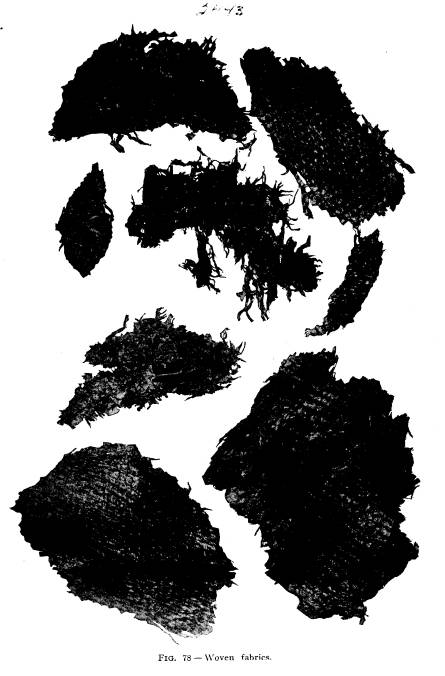
|
190 Ohio Arch. and Hist. Society Publications.
the body. The skeletons were badly decomposed, so much so that not a single perfect bone of any kind was removed from the burials. But few artifacts were interred with the burials, and these consisted of a few notched arrow heads, very well chipped, and many flint knives roughly prepared. Near one of the burials was found a finely polished celt, and with another a tubular pipe, which is shown in Fig. 79. The extra burial forming the twenty- eighth, which constitutes the contents of the mound, was cre- mated, and intrusive to this mound. The grave in which the cremated remains were placed was made some time after the mound had been completed, as the outline of the various layers of clay could readily be seen on the sides of the grave. No logs had been used as support around the side of the grave, which was otherwise similar to those placed above the base line in the Ed- win Harness Mound, but the grave showed that a covering of |
|
|
|
brush and bark, which was set on fire, had been placed over the incinerated remains and the grave covered while it was burning. No artifacts were found with this burial.
RESUME. A brief mention of the more salient points brought out by the examination of a portion of the mound that was abandoned after more than half a century of active efforts manifest in an attempt to examine the mound, as set forth in the preceding pages, will be, perhaps, of interest, and I will briefly give them. The object of the mound was purely mortuary, and the site of the mound a charnel house until it was filled with graves, when the house was destroyed by fire and a mound erected as a monu- ment to the dead. All of the graves in the mound showed a careful preparation for the reception of the remains. |
Explorations of the Edwin Harness
Mound. 191
Of the one hundred and thirty-three,
only five were uncre-
mated, and a majority of those cremated
showed that the last
rite was performed before the grave was
temporarily covered,
by setting fire to the grass and twigs
that covered the grave, and
while burning was covered over with a
layer of clay. This was
done with each burial until the charnel
house was filled.
The artifacts placed in the graves also
show that the builders
of the mound were possessors of a
wonderful wealth of art pro-
ducts, which products had a well marked
individuality, being
superior in every respect to the
artifacts found in the prehistoric
village near Higby, five or six miles to
the south. The Higby
inhabitants were representatives of the
Fort Ancient culture,17
though we find that the Harness Mound
builders were equal in
culture in every respect to the peoples
occupying the Hopewell
group.
The earthworks and mounds of the Harness
group were
purely aboriginal, and from the data
secured from our explora-
tions are representatives of the North
West group described by
Mr. W. H. Holmes,18 and which
so far as the artifacts testify,
are purely Pre-Columbian.
The great body of relics found in the
mound were made of
copper, shell and bone. Especially
noticeable were the ear orna-
ments of copper which were in some
instances covered with iron
and silver, and which display remarkable
workmanship. A care-
ful examination of these finely wrought
implements and orna-
ments plainly shows that the mechanical
art was developed almost
exclusively, while in other sections of
the Scioto Valley, where
the Hopewell Culture is found, the
idiographic art was highly
developed along with the non-imitative.
No perfect pieces of the ceramic art
were exhumed, but the
sherds plainly show that the fictile
products are entitled to a high
place in Ohio ceramic arts.
The great variety of weaving and the
quantity of woven
17I have for my own convenience named the two great cultures
whose remains are so abundant in Ohio,
Fort Ancient Culture and Hope-
well Culture, "Explorations of the
Baum Village Site," Vol. 14, Ohio
State Archaeological and Historical
Publications.
18 Twentieth
Annual Report of the Bureau of Ethonology.
|
Explorations of the Edwin Harness Mound. 193 material found in the graves, indicate that the art was assiduously practiced. The examination of the Robert Harness Mound proved it to be a burial mound belonging to the Fort Ancient Culture, and the finding of a burial of the Hopewell Culture intrusive to the Robert Harness Mound proves without question that the people of the Fort Ancient Culture were the first to occupy the surround- ing territory, and consequently the Hopewell Culture occupied this territory at a later period. |
|
|
|
Vol. XVI.-13. |
